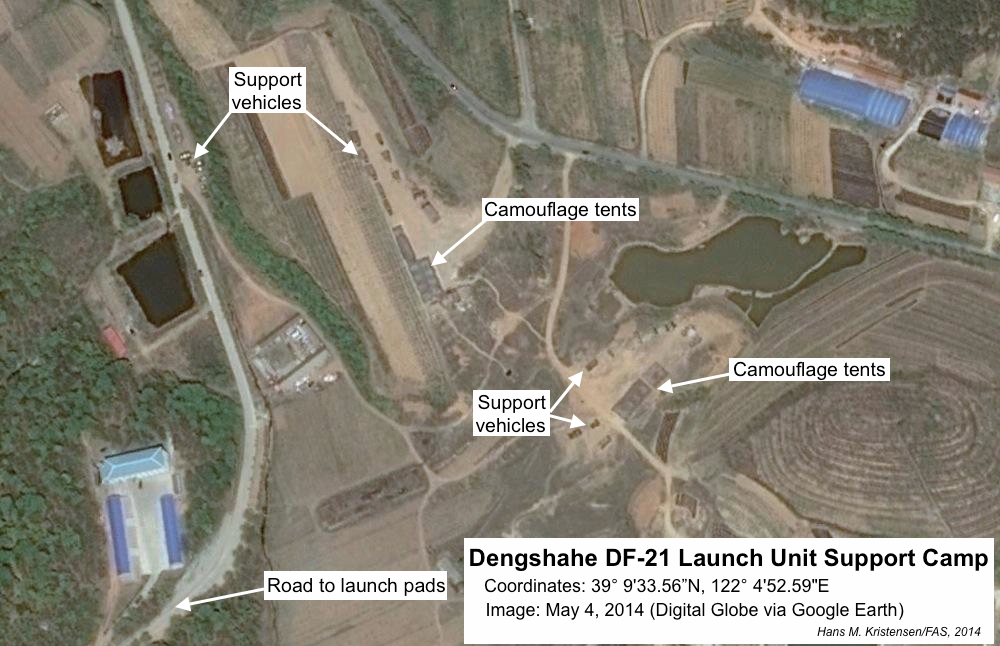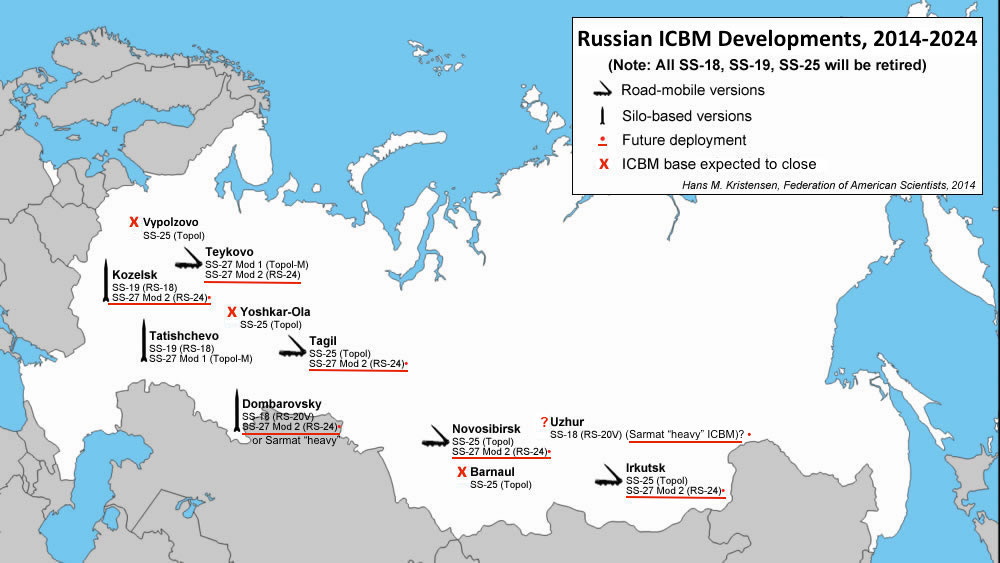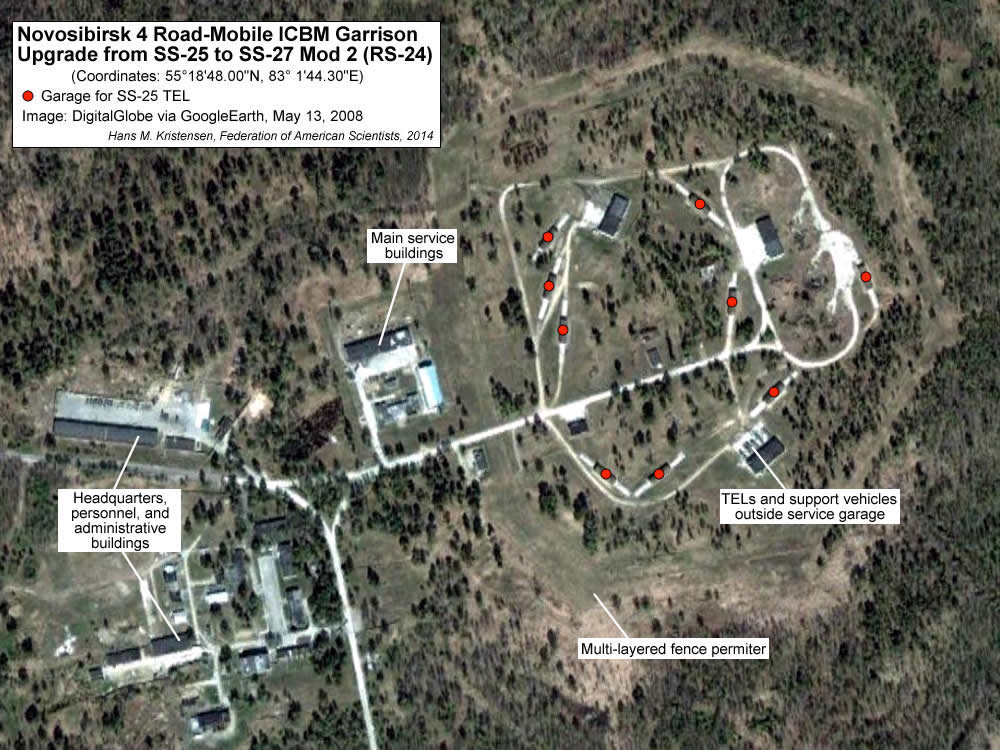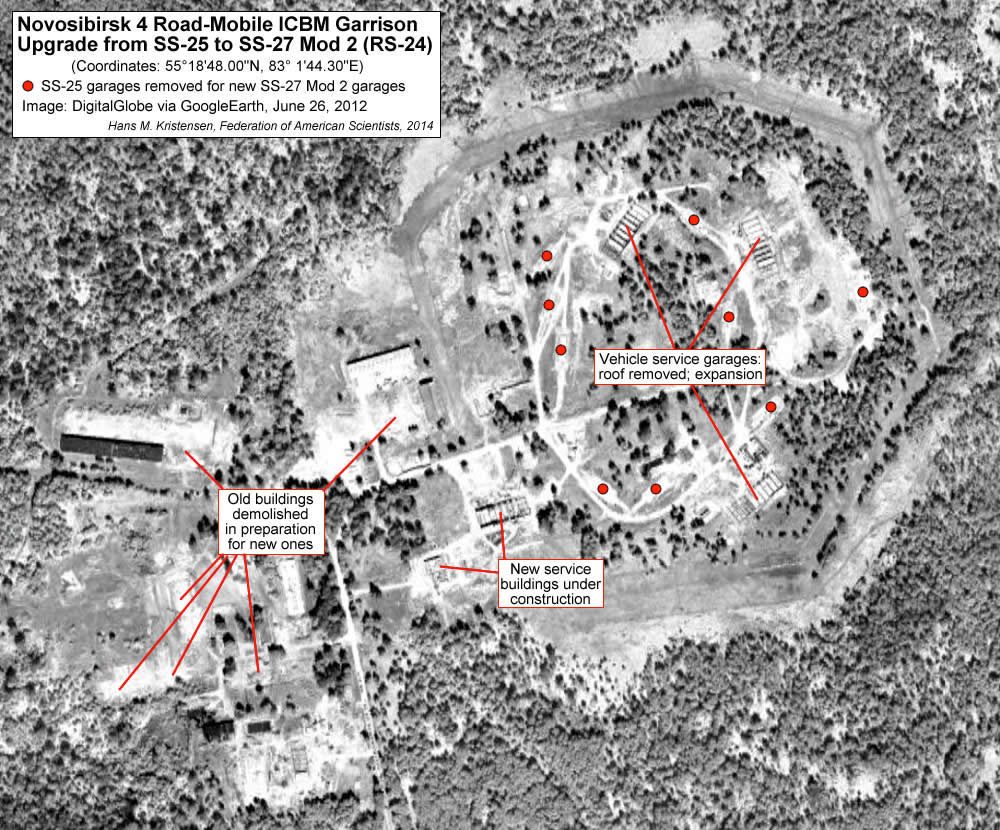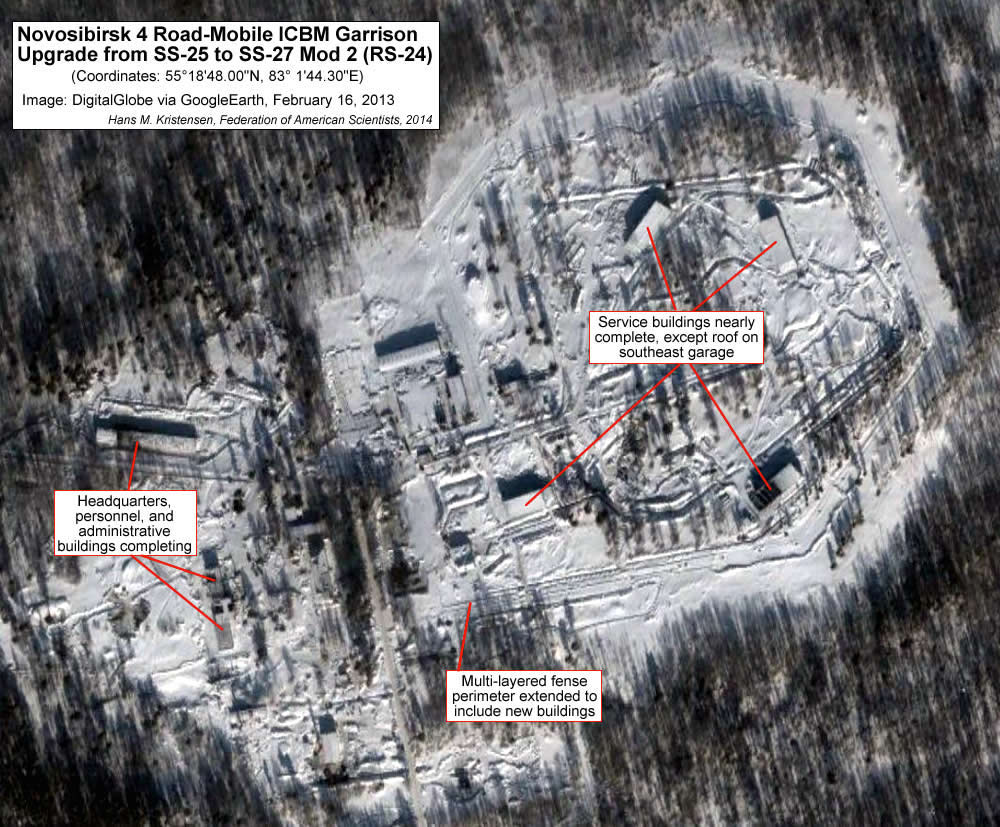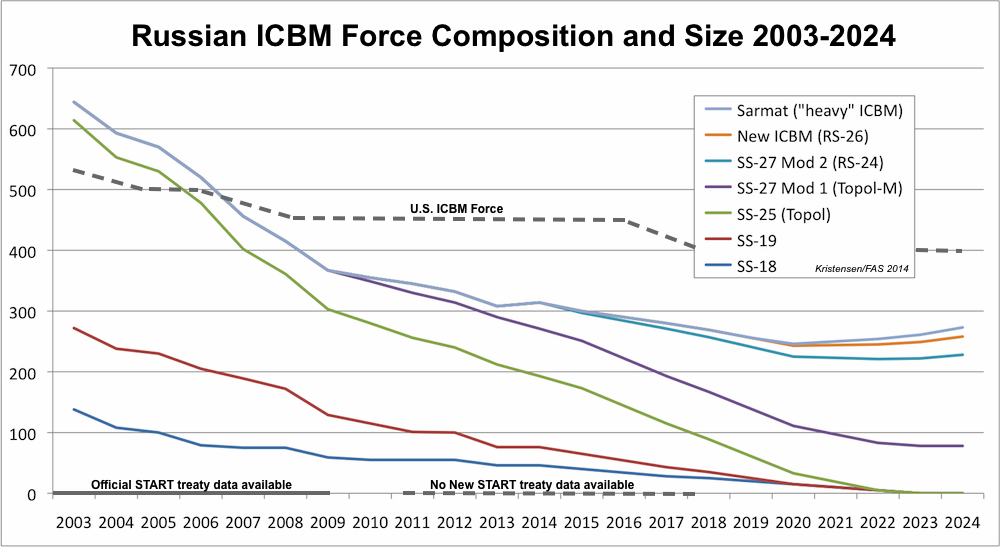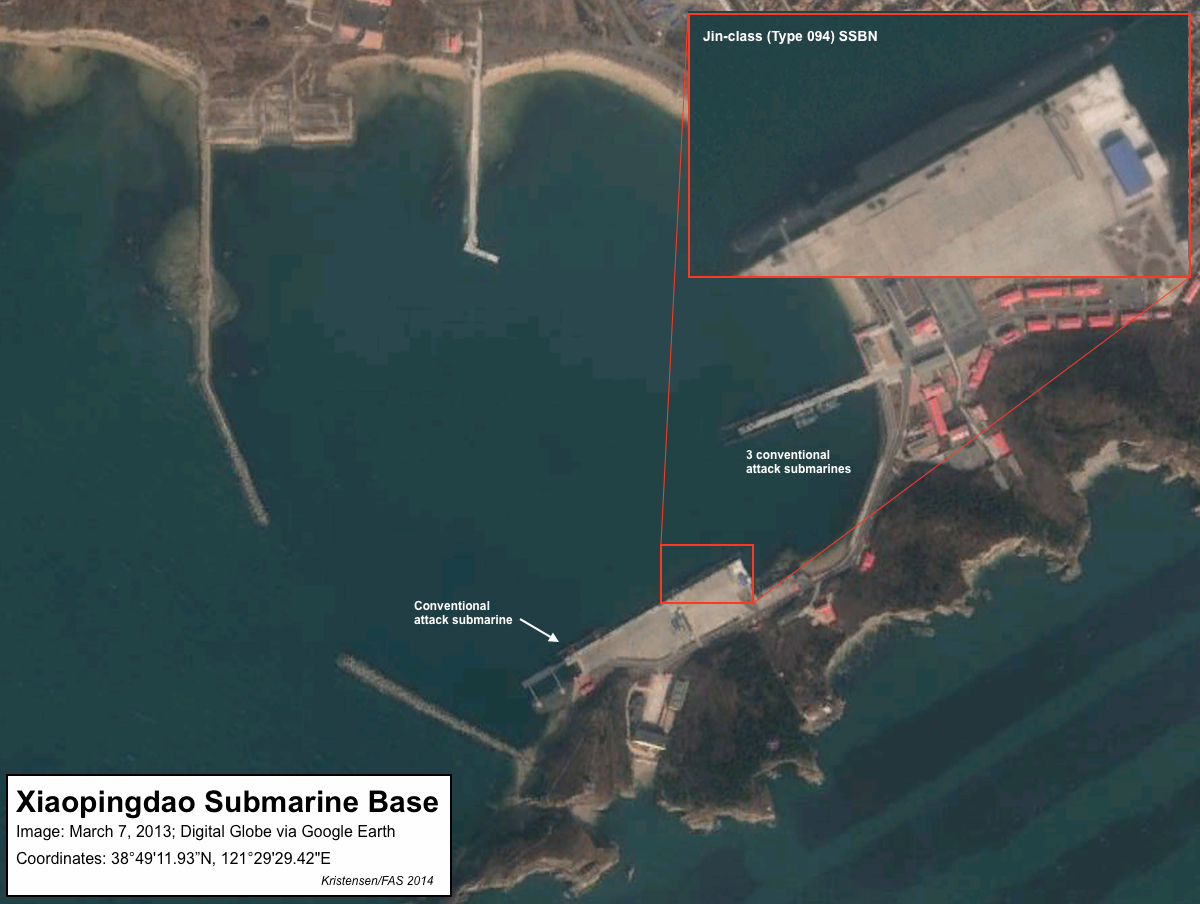What Are Acceptable Nuclear Risks?
When I read Eric Schlosser’s acclaimed 2013 book, Command and Control: Nuclear Weapons, the Damascus Accident, and the Illusion of Safety, I found a tantalizing revelation on pages 170-171, when it asked, “What was the ‘acceptable’ probability of an accidental nuclear explosion?” and then proceeded to describe a 1957 Sandia Report, “Acceptable Premature Probabilities for Nuclear Weapons,” which dealt with that question.
Unable to find the report online, I contacted Schlosser, who was kind enough to share it with me. (We owe him a debt of gratitude for obtaining it through a laborious Freedom of Information Act request.) The full report, Schlosser’s FOIA request, and my analysis of the report are now freely accessible on my Stanford web site. (The 1955 Army report, “Acceptable Military Risks from Accidental Detonation of Atomic Weapons,” on which this 1957 Sandia report builds, appears not to be available. If anyone knows of an existing copy, please post a comment.)
Using the same criterion as this report*, which, of course, is open to question, my analysis shows that nuclear terrorism would have to have a risk of at most 0.5% per year to be considered “acceptable.” In contrast, existing estimates are roughly 20 times higher.**
My analysis also shows, that using the report’s criterion*, the risk of a full-scale nuclear war would have to be on the order of 0.0005% per year, corresponding to a “time horizon” of 200,000 years. In contrast, my preliminary risk analysis of nuclear deterrence indicates that risk to be at least a factor 100 and possibly a factor of 1,000 times higher. Similarly, when I ask people how long they think we can go before nuclear deterrence fails and we destroy ourselves (assuming nothing changes, which hopefully it will), almost all people see 10 years as too short and 1,000 years as too long, leaving 100 years as the only “order of magnitude” estimate left, an estimate which is 2,000 times riskier than the report’s criterion would allow.
In short, the risks of catastrophes involving nuclear weapons currently appear to be far above any acceptable level. Isn’t it time we started paying more attention to those risks, and taking steps to reduce them?
* The report required that the expected number of deaths due to an accidental nuclear detonation should be no greater than the number of American deaths each year due to natural disasters, such as hurricanes, floods, and earthquakes.
** In the Nuclear Tipping Point video documentary Henry Kissinger says, “if nothing fundamental changes, then I would expect the use of nuclear weapons in some 10 year period is very possible” – equivalent to a risk of approximately 10% per year. Similarly, noted national security expert Dr. Richard Garwin testified to Congress that he estimate the risk to be in the range of 10-20 percent per year. A survey of national security expertsby Senator Richard Lugar was also in the 10% per year range.
Italy’s Nuclear Anniversary: Fake Reassurance For a King’s Ransom

A new placard at Ghedi Air Base implies that U.S. nuclear weapons stored at the base have protected “the free nations of the world” after the end of the Cold War. But where is the evidence?
By Hans M. Kristensen
In December 1963, a shipment of U.S. nuclear bombs arrived at Ghedi Torre Air Base in northern Italy. Today, half a century later, the U.S. Air Force still deploys nuclear bombs at the base.
The U.S.-Italian nuclear collaboration was celebrated at the base in January. A placard credited the nuclear “NATO mission” at Ghedi with having “protected the free nations of the world….”
That might have been the case during the Cold War when NATO was faced with an imminent threat from the Soviet Union. But half of the nuclear tenure at Ghedi has been after the end of the Cold War with no imminent threat that requires forward deployment of nuclear weapons in Europe.
Instead, the nuclear NATO mission now appears to be a financial and political burden to NATO that robs its armed forces of money and time better spent on non-nuclear missions, muddles NATO’s nuclear arms control message, and provides fake reassurance to eastern NATO allies.
Italian Nuclear Anniversary
Neither the U.S. nor Italian government will confirm that there are nuclear weapons at Ghedi Torre Air Base. The anniversary placard doesn’t even include the word “nuclear” but instead vaguely refers to the “NATO mission.”
But there are numerous tell signs. One of the biggest is the presence of the 704th Munitions Support Squadron (MUNSS), a U.S. Air Force unit of approximately 134 personnel that is tasked with protecting and maintaining the 20 U.S. B61 nuclear bombs at the base. The MUNSS would not be at the base unless there were nuclear weapons present. There are only four MUNSS units in the U.S. Air Force and they’re all deployed at the four European bases where U.S. nuclear weapons are earmarked for delivery by aircraft of the host nation.

A satellite photo from March this year shows part of the nuclear infrastructure at Ghedi Torre Air Base. Click on image to see full size.
Another tell sign is the presence of NATO Weapons Maintenance Trucks (WMT) at Ghedi. NATO has 12 of these trucks that are specially designed to enable field service of nuclear bombs at the storage bases in Europe. A satellite image provided by Digital Globe via Google Earth shows a WMT parked near the 704th MUNSS quarters at Ghedi on March 12, 2014. An older image from September 28, 2009, shows two WMTs at the same location (see image above).
These trucks will drive out to the 11 individual Protective Aircraft Shelters (PAS) that are equipped with underground Weapons Storage and Security System (WS3) vaults to service the B61 bombs. The WS3 vaults at Ghedi were completed in 1997; before that the weapons were stored in bunkers outside the main base. Once the truck is inside the shelter, the B61 is brought up from the vault, disassembled into its main sections as needed, and brought into the truck for service.
It is during this process of weapon disassembly when the electrical exclusion regions of the nuclear bomb are breached that a U.S. Air Force safety review in 1997 warned that “nuclear detonation may occur” if lightning strikes the shelter.
NATO is in the process of replacing the WMTs with a fleet of new nuclear weapons maintenance trucks known as the Secure Transportable Maintenance System (STMS). The trailers will have improved lightning protection. NATO provided $14.7 million for the program in 2011, and in July 2012 the U.S. Air Force awarded a $12 million contract to five companies in the United States to build 10 new STMS trailers for delivery by June 2014.

NATO’s new mobile nuclear weapons maintenance system is scheduled for delivery to European nuclear bases in 2014. Click image to see full size.
The new trailers will be able to handle the new B61-12 guided standoff nuclear bomb that is planned for deployment in Europe from 2020. The B61-12 apparently will be approximately 100 lbs pounds (~45 kilograms) heavier than the existing B61s in Europe (see slide below) – even without the internal parachute. This suggests that a fair amount of new or modified components will be added. To better handle the heavier B61-12, each trailer will be equipped with hoist rails.

The new B61-12 bomb will be heavier than the B61s currently deployed in Europe. For pictures of actual B61-12 features, click here.
The deployment to Ghedi 50 years ago was not the earliest or only deployment of U.S. nuclear weapons to Italy. During the Cold War, ten different U.S. nuclear weapon systems were deployed to Italy. The first weapons to arrive were Corporal and Honest John short-range ballistic missiles in August 1956. They were followed by nuclear bombs in April 1957 and nuclear land mines in 1959. All but one – nuclear bombs – of these nuclear weapon systems have since been withdrawn and scrapped.
A decade ago, most B61s in Europe were stored in Germany and the United Kingdom, but today, Italy has the honor of being the NATO country with the most U.S. nuclear weapons deployed on its territory; a total of 70 of all the 180 B61 bombs remaining in Europe (39 percent). Italy is also the only country with two nuclear bases: the Italian base at Ghedi and the American base at Aviano. Aviano Air Base is home to the U.S. 31st Fighter Wing with two squadrons of nuclear-capable F-16 fighter-bombers. One of these, the 555th Fighter Squadron, was temporarily forward deployed to Lask Air Base in Poland in March 2014.
The nuclear “NATO mission” that the 6th Stormo wing at Ghedi Torre Air Base serves means that Italian Tornado aircraft are equipped and Italian Tornado pilots are trained in peacetime to deliver U.S. nuclear weapons in wartime. This arrangement dates back to before the nuclear Non-Proliferation Treaty (NPT), but it is increasingly controversial because Italy as a signatory to the NPT has pledged “not to receive the transfer from any transferor whatsoever of nuclear weapons…or of control over such weapons…directly, or indirectly.”
The United States, also a signatory to the NPT, has committed “not to transfer to any recipient whatsoever nuclear weapons…or control over such weapons…directly, or indirectly; and not in any way to assist, encourage, or induce any non-nuclear-weapon State to…acquire nuclear weapons…, or control over such weapons….”
In peacetime, the B61 nuclear bombs at Ghedi are under the custody of the 704th MUNSS, but the whole purpose of the NATO mission is to equip, train and prepare in peacetime for “transfer” and “control” of the U.S. nuclear bombs to the Italian air force in case of war.
The Nuclear Burden
Maintaining the NATO nuclear strike mission in Europe does not come cheap or easy but “steals” scarce resources from non-nuclear military capabilities and operations that – unlike tactical nuclear bombs – are important for NATO.
Italy pays for the basing of the U.S. Air Force 704th MUNSS at Ghedi, for security upgrades needed to protect the weapons at the base, and for training pilots and maintaining Tornado aircraft to meet the stringent certification requirements for nuclear strike weapons. Moreover, the cost of securing the B61 bombs at the European bases is expected to more than double over the next few years (to $154 million) to meet increased U.S. security standards for storage of nuclear weapons.
But these costs are getting harder to justify given the serious financial challenges facing Italy. The air force’s annual flying hours dropped form 150,000 in 1990 to 90,000 in 2010, training reportedly declined by 80 percent from 2005 to 2011, and training for air operations other than Afghanistan apparently has been “pared to the bone.” In addition, the Italian defense posture is in the middle of a 30-percent contraction of the overall operational, logistical and headquarters network spending. The F-35 fighter-bomber program, part of which is scheduled to replace the current fleet of Tornados in the nuclear strike mission, has already been cut by a third and the new government has signaled its intension to cut the program further.
Under such conditions, maintaining a nuclear mission for the Italian air force better be really important.
Most of the costs of the European nuclear mission are carried by the United States. Over the next decade, the United States plans to spend roughly $10 billion to modernize the B61 bomb, over $1 billion more to make the new guided B61-12 compatible with four existing aircraft, another $350 million to make the new stealthy F-35 fighter-bomber nuclear-capable, and another $1 billion to sustain the deployment in Europe.
This adds up to roughly $12.5 billion for sustaining, securing, and modernizing U.S. nuclear bombs in Europe over the next decade. Whether the price tag is worth it obviously must to be weighed against the security benefits it provides to NATO, how well the deployment fits with U.S. and NATO nuclear arms control policy, and whether there are more important defense needs that could benefit from that level of funding.
Fake Versus Real Reassurance
The anniversary placard displayed at Ghedi Air Base claims that the U.S. non-strategic nuclear bombs have “protected the free nations of the world” even after the end of the Cold War. And during the nuclear safety exercise at Ghedi in January, the commander of the U.S. Air Force 52nd Fighter Wing told the U.S. and Italian security forces that “your mission today is still as relevant as when together our country stared down the Soviet Union alongside a valued member of our enduring alliance.” (Emphasis added).
That is probably an exaggeration, to put it mildly. In fact, it is hard to find any evidence that the deployment of non-strategic nuclear weapons in Europe after the end of the Cold War has protected anything or that the mission is even remotely as relevant today. The biggest challenge today seems to be to protect the weapons and to find the money to pay for it.
NATO’s response to Russia’s invasion of Ukraine, moreover, strongly suggests that NATO itself does not attribute any real role to the non-strategic nuclear weapons in reassuring eastern NATO allies of a U.S. commitment to defend them. Yet this reassurance role is the main justification used by proponents of the deployment. In hindsight, the reassurance effect appears to be largely doctrine talk, while NATO’s actual response has focused on non-nuclear forces and exercises.
To the extent that a potential nuclear card has been played, such as when three B-52 and two B-2 nuclear-capable bombers were temporarily deployed to England earlier this month, it was done with long-range strategic bombers, not tactical dual-capable aircraft. The fact that nuclear fighter-bombers were already in Europe seemed irrelevant. The same was done in March 2013, when the United States deployed long-range bombers over Korea to reassure South Korea and Japan against North Korean threats.
No eastern European ally has said: “Hold the bombers, hold the paratroopers, hold the naval exercises! The B61 nuclear bombs in Italy, Germany, Belgium, the Netherlands and Turkey are here to reassure us against Russia.”
In the real world, the non-strategic nuclear weapons in Europe are fake reassurance because they are useless and meaningless for the kind of crises that face NATO allies today or in the foreseeable future. NATO pays a king’s ransom for the deployment with very little to show for it.
President Obama has asked for $1 billion to reassure Europe against Russia. But he could get a dozen non-nuclear European Reassurance Initiatives for the price of sustaining, modernizing, and deploying the non-strategic nuclear bombs in Europe. Doing so would help “put an end to Cold War thinking” as he promised in Prague five years ago.
This publication was made possible by a grant from the Ploughshares Fund and New Land Foundation. The statements made and views expressed are solely the responsibility of the author.
DOD Report Shows Chinese Nuclear Force Adjustments and US Nuclear Secrecy

The Pentagon’s latest report to Congress on Chinese military developments cost $89.000 to prepare but no longer includes a list of China’s nuclear arsenal.
The Pentagon’s latest annual report to Congress on the Military and Security Developments Involving the People’s Republic of China describes continued broad modernization and growing reach of Chinese military forces and strategy.
There is little new on the nuclear weapons front in the 2014 update, however, which describes slow development of previously reported weapons programs. This includes construction of a handful of ballistic missile submarines; the first of which the DOD predicts will begin to sail on deterrent patrols later this year.
It also includes the gradual phase-out of the old DF-3A liquid-fuel ballistic missile and the apparent – and surprising – stalling of the new DF-31 ICBM program.
Like all the other nuclear-armed states, China is modernizing its nuclear forces. China earns the dubious medal (although not in the DOD report) of being the only nuclear weapons state party to the nuclear Non-Proliferation Treaty that is increasing it nuclear arsenal. Far from a build-up, however, the modernization is a modest increase focused on ensuring the survivability of a secure retaliatory strike capability (see here for China’s nuclear arsenal compared with other nuclear powers).
The report continues the Obama administration’s don’t-show-missile-numbers policy. Up until 2010, the annual DOD reports included a table overview of the composition of the Chinese missile force. But the overview gradually became less specific in until it was completed removed from the reports in 2013.
The policy undercuts the administration’s position that China should be more transparent about its military modernization by indirectly assisting Chinese government secrecy.
The main nuclear issues follow below.
Land-Based Nuclear Missile Developments
The DOD report formally identifies the new road-mobile ICBM under development as the DF-41, rumored at least since 1997 to be in development. The missile might “possibly [be] capable of carrying multiple independently targetable re-entry vehicles (MIRV),” according to DOD. That obviously doesn’t mean that the DF-41 will carry them; the DF-5A has also been assessed for years to be capable of carrying MIRV without ever doing so.
The report lends some support to the assessment – although not explicitly – that deployment of the DF-31 ICBM has ceased after only 5-10 launchers deployed in a single brigade.
Instead, the focus of the road-mobile ICBM modernization appears to have shifted to the DF-31A ICBM, of which the DOD report predicts that more will be deployed by 2015.
The liquid-fuel DF-3A (CSS-2) IRBM is not mentioned in the 2014 report, an indication that the 3.3-megaton weapon system has finally been retired after 42 years in service. The last DF-3A-equipped Second Artillery brigade – the 810 Brigade north of Dalian in the Liaoning province – was seen in May 2014 to have been converted to the solid-fuel medium-range DF-21 MRBM.

The 2014 DOD report appears to indicate that the 3.3-megaton, liquid-fuel DF-3A IRBM has been retired after 42 years in service.
The only other transportable liquid-fuel ballistic missile, the DF-4 (CSS-3) ICBM, is still operational with 10-15 launchers deployed in one or two brigades. But the missile is expected to be retired soon. When that happens, the only liquid-fuel ballistic missile left in the Chinese arsenals will be the 20 silo-based DF-5As (CSS-4 Mod 1) ICBM, which are still being ungraded.
The report also mentions conventional ballistic missiles under development, including several medium-range versions. That includes that anti-ship version of the DF-21 (CSS-5) – the DF-21D, which the report designates as the CSS-5 Mod 5. That suggests that other conventional MRBMs may also be under development.
Sea-Based Nuclear Missile Developments
The DOD report states that three Jin-class (Type 094) SSBNs have been delivered and that two more are in various stages of construction. One of these was seen at the Bohai shipyard in October 2013. After the Jin-program is completed, DOD expects that China will proceed to its next-generation SSBN (Type 096) over the next decade.
The report makes the prediction that “China is likely to conduct its first nuclear deterrence patrols with the JIN-class SSBN in 2014,” assuming that the JL-2 SLBM will finally become operational.

The DOD report predicts that the Jin-class SSBNs (one seen here at Xiaopingdao) likely will conduct China’s first “nuclear deterrent patrols” in 2014, even though the Chinese Central Military Commission is through to insist on central control of Chinese warheads under normal circumstances.
The prediction of the upcoming nuclear deterrent patrols is controversial given that the Chinese leadership so far has been very reluctant to hand over nuclear weapons to the military under normal circumstances. China has never conducted a SSBN deterrent patrol before and a Jin SSBN deploying with nuclear warheads loaded on its SLBMs would constitute a significant change in Chinese nuclear operational policy. It would also constitute the first-ever deployment of Chinese nuclear weapons outside the land-territory of China.
Nuclear-Capable Cruise Missile Developments
The DOD report does not explicitly attribute nuclear capability to China’s growing inventory of land-attack cruise missiles. Yet the 2013 NASIC report designates the DH-10 ground-launched cruise missile as “conventional or nuclear,” the same designation given to the Russian AS-4 and the Pakistani Ra’ad and Babur cruise missiles, weapons widely assumed to be nuclear-capable.

The DH-10 ground-launched land-attack cruise missile is described by NASIC as “conventional or nuclear,” the same designation given to Russian and Pakistani dual-capable nuclear cruise missiles.
There are widespread rumors on Chinese Internet sites that the DH-10 has been modified for delivery by the H-6K intermediate-range bomber. It is unknown if that includes the apparently nuclear-capable version.
In addition, US Air Force Global Strike Command last year attributed the CJ-20 air-launched cruise missile with nuclear capability, but neither NASIC nor the DOD does so.
Additional background: FAS Nuclear Notebook: Chinese Nuclear Forces, 2013
This publication was made possible by a grant from the Ploughshares Fund and New Land Foundation. The statements made and views expressed are solely the responsibility of the author.
The Evolution of the Senate Arms Control Observer Group
In March 2013, the Senate voted down an amendment offered by Senator Rand Paul (R-KY) to cut $700,000 from their budget that was set-aside for the National Security Working Group (NSWG). What many did not realize at the time was that this relatively small and obscure proposed cut would have eliminated one of the last traces of the bipartisan Congressional approach to debating arms control.
The NSWG first began as the Arms Control Observer Group, which helped to build support for arms control in the Senate. In recent years, there have been calls from both Democrats and Republicans to revive the Observer Group, but very little analysis of the role it played. Its history illustrates the stark contrast in the Senate’s attitude and approach to arms control issues during the mid- to late 1980s compared with the divide that exists today between the two parties.
The Arms Control Observer Group
The Arms Control Observer Group was first formed in 1985. At the time, the United States was engaged in talks with the Soviet Union on the Intermediate Nuclear Forces Treaty. To generate support for ongoing negotiations, Majority Leader Senator Bob Dole (R-KS), and Minority Leader Senator Robert Byrd (D-WV), with the endorsement of President Ronald Reagan, created the bipartisan Arms Control Observer Group. The Observer Group consisted of twelve senators, with four senators, two from each party, serving as co-chairs and created an official role for senators to join U.S. delegations as they negotiated arms control treaties. As observers, its members had two duties: to consult with and advise U.S. arms control negotiating teams, and “to monitor and report to the Senate on the progress and development of negotiations.”
During meetings with U.S. State Department negotiators, senators were able to present their views, ask questions, and even engage in candid and confidential exchanges of ideas and information. Senators were also allowed to meet with members of the Soviet delegations on an “informal” basis. The Observer Group believed that the “interplay of ideas” would assist negotiators and, if negotiations failed, the members would help their fellow senators explain the reasons why to the American public.
The Observer Group served a number of purposes. First, it was intended to supplement the activities of the Senate Foreign Relations Committee. Senator Byrd argued that the process that existed up until that point—where the Foreign Relations Committee became experts on treaties and the full Senate only began to understand the issues after the negotiation—was not functioning properly. Its creators argued, “the full Senate has focused its attention in the past only sporadically on the vital aspects of arms control negotiations, usually developing a knowledge and understanding of the issues being negotiated after the fact…the result of this fitful process has been generally unsatisfactory in recent years.” During the previous decade, the Executive Branch had failed to garner enough Senate support for several arms control initiatives: the Peaceful Nuclear Explosions Treaty of 1976, the Threshold Test Ban Treaty of 1974, and the Strategic Arms Limitation Treaty (SALT II) of 1979, none of which were ratified by the United States. Although there had been previous attempts to involve senators in arms control negotiations, the Observer group provided “more regular and systematic involvement” from the full Senate long before a vote took place.
The formation of the Observer Group publicly demonstrated the important role of arms control in national security matters. The resolution that created the group states that senators have the “obligation to become as knowledgeable as possible concerning the salient issues, which are being addressed in the context of the negotiating process. Any accord with the Soviet Union to control or reduce our strategic weapons carries considerable weight for our nation.” According to Senator Sam Nunn (D-GA), a founding member of the Observer Group, “the goal [was] to have the Senate fulfill both halves of its constitutional responsibilities, not only the consent half—that’s what we’ve been looking to primarily in the past—but also the advice half.”
Additionally, the Observer Group helped develop institutional knowledge and expertise on arms control within the Senate. The Group’s founding members stated that they believed it was necessary to become “completely conversant” in issues related to treaty negotiations and that such knowledge was “critical” to the Senate’s understanding of the issues involved. To achieve that goal, they held regular behind closed-door briefings on negotiations for senators and their staff and some staffers were able to review related classified materials. Observer Group members were conversant in issues related to previous arms control treaties, missile defense, the connection between strategic offense and defense, and treaty compliance.
Above all, the Observer Group was intended to help build bipartisan support for President Reagan’s arms control initiatives. The group was seen as a mediating body. When it was formed, Senators Dole and Byrd co-authored a resolution stating that the Observer Group was part of “an ongoing process to reestablish a bipartisan spirit in this body’s consideration of vital national security and foreign policy issues.” Senator Richard Lugar (R-IN), who was one of the original members of the Observer Group, agreed by affirming, “The observer group is tremendously important to forming a consensus on which ratification might occur.” The Group’s 1985 report to Congress endorsed “the broad bipartisan support of the Senate for the Administration’s arms control efforts…determination to be as patient as necessary to achieve a sound agreement…the seriousness with which the Senate, including the Observer group intends to fulfill its constitutionally-mandated role in the treaty-making process.” This opinion was also shared by the Reagan administration. In a letter to Senators Dole and Byrd, Secretary of State George Shultz stated that he thought the Observer Group would help facilitate unity on arms control.
It is difficult to demonstrate the extent of its influence as the years the Observer Group was most active were also the years in which arms control was seen by both parties as a vital part of U.S. policy. The success of these initiatives was clearly not solely due to the Observer Group, but it did play a role. Every one of the original Group’s members voted in favor of the INF Treaty in 1988, which passed 93-5. Similarly, all of the senators within the Group voted in favor of ratifying the 1992 START Treaty, which passed 93-6.
The National Security Working Group
Towards the end of the 1990s, the Senate’s attitude towards arms control changed. Negotiations between the United States and Russia on a legally binding nuclear reduction treaty had stalled. The Senate had voted down the Comprehensive Test Ban Treaty. Reflecting this changing point of view, in 1999, Senator Trent Lott (R-MS), wanted to further diminish the Senate’s focus and expertise on arms control issues. He proposed an amendment that expanded the Observer Group’s purview to include observing talks related to missile defense and export controls and renamed it the National Security Working Group. For nearly a decade during the George W. Bush administration, which pursued relatively little in terms of legally binding arms control agreements, the NSWG was relatively dormant.
This changed in 2009 under the Obama administration when the Executive Branch started briefing senators about the ongoing New Strategic Arms Reduction Treaty (New START) negotiations. From July 6, 2009, when President Obama and Russian President Dmitry Medvedev signed an agreement to reduce American and Russian nuclear arsenals, to April 10, 2010, when they signed the negotiated treaty, the NSWG was revived in order to give senators a role in observing the negotiation process. During this ten-month period, the NSWG began meeting again. The meetings were open to members of the Armed Services and Foreign Relations committees and were well attended, with roughly 50 percent attendance from those who were invited. Senators who participated in the Working Group knew it was a serious matter and paid attention to it. As a result of their attendance, they left meetings better informed on issues related to arms control.
Throughout the course of Senate deliberation of New START, Senator Jon Kyl (R-AZ) served as the Republican Party’s key interlocutor with Democrats. Unlike his predecessors in the Observer Group, Senator Kyl did not see the Working Group as a vehicle for bipartisan cooperation and consensus building. Senator Kyl used his position as the chief negotiator to disrupt the Obama administration’s legislative agenda on arms control.
Senator Kyl used issues peripheral to the treaty, such as missile defense and modernization of the nuclear stockpile, to “slow roll” the legislative process and prevent the administration from pursuing the Comprehensive Test Ban Treaty, which he ardently opposed.1 According to one account, Senator Kyl “was not using the Working Group. It was just a tool to stop the policy. There wasn’t a getting to yes option. It wasn’t there to get to yes. If the members of the group aren’t inclined to get to yes, then the mechanism won’t get them there.” Further, he “came prepared to ask tough questions, not just to listen and probe. He was there to look for chinks in the arms and attack in front of his colleagues. He wanted his colleagues to see it.”
In an effort to prevent Senator Kyl from disrupting meetings, Senate staff made the NSWG open to all members of the Senate Foreign Relations and Armed Services Committees. They also made sure that senior Democratic leadership was present for all of the NSWG meetings. Either Senator John Kerry (D-MA) or Carl Levin (D-MI) served as Chair and were both prepared to answer all questions and concerns.
Despite this impediment, senators still appear to have found the Working Group useful. Senator Levin, Chairman of the Senate Armed Services Committee, said the NSWG provided an opportunity to bring senators in at the beginning of the negotiation process, and “through the group” there were “many opportunities to learn of the progress and details of negotiations and to provide our advice and views to the administration throughout the process.” He praised the NSWG’s work, arguing that it was a “key” part of the treaty ratification process because it allowed senators to begin meeting with the administration “early in the process of negotiation” before New START was finalized. He said that during the New START process, “members of the National Security Working Group asked a great number of questions, received answers at a number of meetings, stayed abreast of the negotiation details, and provided advice to the administration.” Finally, he added that, through the NSWG, the administration had the opportunity to respond to senators’ questions and concerns, which helped to avoid problems during the Senate’s consideration of the treaty.
The Senate was less supportive of arms control this time around. Even with senators actively involved in the NSWG, only 13 Republicans ended up supporting the treaty. Of those 13, only four Republicans were members of the Working Group (Senators Lugar, Corker, Voinovich, and Cochran). Among those four, only Senator Lugar was a particularly strong advocate for the treaty.
At best, the Working Group had a mixed track record and certainly did not have the same kind of success as the Observer Group. Only two senators traveled to observe New START negotiations. There was no spirit of cooperation or strong bipartisan support for the treaty. The Working Group essentially became a courtroom where New START could be prosecuted.
The Future of the NSWG
Since the vote on New START, the NSWG has not been any more successful in helping to foster bipartisanship. At the beginning of the 113th session of Congress, Senator Dianne Feinstein (D-CA) and Senator Marco Rubio (R-FL) were appointed co-chairs. Senator Rubio, like Senator Kyl, has attempted to impede the Obama Administration’s work on arms control.
While the cooperative atmosphere that surrounded the Arms Control Observer Group seems like an anachronism in today’s political climate, this is not meant to argue that senators within the Working Group need to agree on everything. There were major disagreements over nuclear policy during the Reagan administration and at times, heated discussions within the Observer Group. The difference was that the Observer Group was effective because the senators who were in it believed that arms control could advance U.S. national interests and wanted the group to succeed.
Today, the NSWG suffers from three broader trends within the United States that inhibit this attitude. The first is that the partisanship that exists in the Working Group is a reflection of the divisions in Congress. Given this dynamic, if there is any chance for the NSWG to serve as a valuable forum, individuals looking for the spotlight cannot be given the opportunity to hijack it. Secondly, since the end of the Cold War, detailed, negotiated arms control agreements are decreasingly seen as important to advancing U.S. national interests. There is diminishing prestige or interest in being a member of the NSWG or in supporting arms control. Thirdly, the Republican Party is far more skeptical about any legally binding international commitments than it once was.
These trends are unfortunate. The fact is that arms control still has a role to play in advancing U.S. interests and promoting international peace and stability. There are numerous issues that the United States and Russia will still need to address together. They continue to cooperate on issues related to Iran and reducing the risk of nuclear terrorism. They will likely still continue to communicate about issues related to U.S. missile defense deployment. Some think that current problems between the United States and Russia are evidence that this is not the case, but it was this kind of tension that led both countries to arms control in the first place. For this reason, diplomacy will remain an important policy tool for preventing catastrophic war between the two countries.
With diminishing nuclear policy expertise in a divided Senate, there is a need for a group of engaged, knowledgeable senators invested in arms control. For this reason, the NSWG will continue to have the opportunity to play a constructive role in informing the Senate on these issues and allowing senators into the diplomatic process.
The first members of the Group were Senator Ted Stevens (R-Alaska), Sam Nunn (D-Georgia), Richard Lugar (R-Indiana), Claiborne Pell (D-Rhode Island), Al Gore (D-Tennessee), Ted Kennedy (D-Massachusetts), Pat Moynihan (D-New York), Don Nickles (R-Oklahoma), John Warner (R-Virginia), and Malcolm Wallop (R-Wyoming).
Foreword, Report of the Senate Arms Control Observer Group Delegation to the Opening of the Arms Control, Negotiations with the Soviet Union in Geneva, Switzerland, March 9-12, (III) 1985.
Origin and Summary of Activities, Report of the Senate Arms Control Observer Group Delegation to the Opening of the ArmsControl, Negotiations with the Soviet Union in Geneva, Switzerland, March 9-12, 1985.
Transcript of Press Conference of Observer Group in Geneva, March 12, 1985, Report of the Senate Arms Control Observer Group Delegation to the Opening of the Arms Control, Negotiations with the Soviet Union in Geneva, Switzerland, March 9-12, 1985.
Origin and Summary of Activities, Report of the Senate Arms Control Observer Group Delegation to the Opening of the Arms Control, Negotiations with the Soviet Union in Geneva, Switzerland, March 9-12, 1985.
Janne E. Nolan, “Preparing for the 2001 Nuclear Posture Review,” Arms Control Today, November 2000, http://www.armscontrol.org/act/2000_11/nolan
Congressional Staffer (April 4, 2013), personal interview.
Kyl, Jon, Memo to National Security Working Group Republican Members: Report on the NSWG CODEL to Observe the Geneva Negotiations, November 23, 2009, http://www.foreignpolicy.com/images/091123_20091121_-_Kyl_Memo_to_NSWG_-_NSWG_START_mission.pdf.
Senator Carl Levin (MI), “Authorizing Expenditures by Committees,” Congressional Record (March 5, 2013), p. S1103.
Kristine Bergstrom, “Rubio vs Gottemoeller: The New Partisan Politics of Senate Nuclear Confirmations,” Carnegie Endowment for International Peace, March 7, 2014, http://carnegieendowment.org/2014/03/07/rose-gottemoeller-marco-rubio-and-new-partisan-politics-of-senate-nuclear-confirmations/h2mq.
Nickolas Roth is a research associate at the Project on Managing the Atom in the Belfer Center for Science and International Affairs at Harvard Kennedy School. Nickolas Roth previously worked as a policy analyst at the Union of Concerned Scientists, where he wrote extensively about the industrial infrastructure responsible for maintaining the nuclear weapons stockpile. Mr. Roth has a B.A. in History from American University and a Masters of Public Policy from the University of Maryland, where he is currently a research fellow. Mr. Roth’s written work has appeared or been cited in dozens of media outlets around the world, including the Washington Post, Los Angeles Times, USA Today, Asahi Shimbun, Boston Globe, and Newsweek.
American Scientists and Nuclear Weapons Policy
“Those who don’t know history are destined to repeat it,” warned British statesman and philosopher Edmund Burke more than 200 years ago. Having recently delved into reading about the history of the first group of American atomic scientists and their efforts to deal with the nuclear arms race, I have realized that Burke was right. More so, I would underscore that the ideas of these intellectual path-breakers are still very much alive today, and that even when we are fully cognizant of this history we are bound to repeat it. By studying these scientists’ ideas, Robert Gilpin in his 1962 book, American Scientists and Nuclear Weapons Policy, identifies three schools of thought: (1) control, (2) finite containment, and (3) infinite containment.
The control school had its origins in the Franck Report, which had James Franck, an atomic scientist at the Metallurgical Laboratory at the University of Chicago serve as the lead drafter of the report which argued that “any international agreement on prevention of nuclear armaments must be backed by actual and efficient controls.” Seventy Manhattan Project scientists signed this report in June 1945, which was then sent to Secretary of War Henry Stimson. They suggested that instead of detonating atomic bombs on Japan, the United States might demonstrate the new weapon on “a barren island” and thus say to the world, “You see what sort of a weapon we had but did not use. We are ready to renounce its use in the future if other nations join us in this renunciation and agree to the establishment of an efficient control.” As we all know, the United States government did not take this advice during the Second World War.
But in 1946, the United States put forward in the Acheson-Lilienthal Report (in which J. Robert Oppenheimer, scientific director of the Manhattan Project, served as the lead drafter) ideas for international control of atomic energy. In the form of the Baruch Plan, this proposal before the fledging United Nations faced opposition from the Soviet Union, which wanted to arm itself with nuclear weapons before accepting a U.S. plan that could leave the United States wielding a monopoly on nuclear arms. However, the control school has been kept alive in part, through the founding in 1957 of the International Atomic Energy Agency, which has the dual mission to promote peaceful nuclear power and safeguard these programs. Periodically, concepts are still put forward to create multilateral means to exert some control over uranium enrichment and reprocessing of plutonium, the methods to make fissile material for nuclear reactors or bombs. Many of the founders and leading scientists of FAS such as Philip Morrison and Linus Pauling belonged to the control school.
Starting in the late 1940s, disillusionment about the feasibility of international control was setting in among several atomic scientists active in FAS and advisory roles for the government. They began to see the necessity for making nuclear weapons to contain the Soviet Union. Nonetheless, there were those who believed that international controls should continue to be pursued in parallel with production of atomic bombs. Thus, a sharp division did not exist between the control and finite containment schools of thought. Oppenheimer exemplified this view in a speech on September 17, 1947, to the National War College where he extolled the “soundness” of the control proposals but lamented that “the very bases for international control between the United States and the Soviet Union were being eradicated by a revelation of their deep conflicts of interest, the deep and apparently mutual repugnance of their ways of life, and the apparent conviction on the part of the Soviet Union of the inevitably of conflict—and not in ideas alone, but in force.”
Reading this, I think of the dilemma the United States faces with Iran over efforts to control the Iranian nuclear program while confronting decades of mistrust. One big difference between Iran and the Soviet Union is that Iran, as a non-nuclear weapon state party to the Nuclear Non-Proliferation Treaty, is legally obligated to not make or acquire nuclear explosives whereas the Soviet Union never had such legal restrictions. Thus, Iran has already agreed to accept controls through safeguards on its nuclear program. The question is what additional controls Iran will agree to accept in order to provide needed assurances that it does not have a nuclear weapons program and will not develop such in the future. In parallel, the United States is strengthening containment mostly via a military presence in the Persian Gulf region and providing weapons and defense systems to U.S. allies in the Middle East. Scientists play vital roles both in improving methods of control via monitoring, safeguarding, and verifying Iran’s nuclear activities and in designing new military weapon systems for containment through the threat of force.
How much military force is enough to contain or deter? The scientists who believed in finite containment were generally reluctant, and even some were opposed, to advocating for more and more powerful weapons. As Gilpin examines in his book, the first major schism among the scientists was during the internal government debate in 1949 and 1950 about whether to develop the hydrogen bomb. In particular, the finite containment scientists on the General Advisory Committee to the Atomic Energy Commission assessed that “an American decision not to construct the hydrogen bomb would again symbolize the sincerity of America’s desire to end the atomic arms race.”
In contrast, the infinite containment school that included Edward Teller (who was instrumental in designing the hydrogen bomb), and Ernest Lawrence (who was a scientific leader during the Manhattan Project and was based at the University of California, Berkeley), “argued that control over nuclear weapons would only be possible in a completely open world such as that envisioned in the Baruch Plan. Under the conditions of modern science, the arms race would therefore be unavoidable until the political differences underlying that arms race were settled” in the words of Gilpin. Many of the infinite containment scientists were the strongest advocates for declassifying nuclear secrets as long as there were firm assurances that nations had joined together to prevent the use of nuclear energy for military purposes or that “peace-loving nations had a sufficient arsenal of atomic weapons [to] destroy the will of aggressive nations to wage war.” In effect, they were arguing for world government or for a coalition of allied nations to enforce world peace.
Readers will be reminded of many instances in which history has repeated itself as mirrored by the control, finite containment, and infinite containment ways of thought arising from the atomic scientists’ movement of the 1940s and 1950s. Despite the disagreements among these “schools,” a common belief is that the scientists “knew that technical breakthroughs rarely come unless one is looking for them and that if the best minds of the country were brought in to concentrate on the problem, someone would find a solution … if there were one to be found,” according to Gilpin. Gilpin also astutely recommended that “wisdom flourishes best and error is avoided most effectively in an atmosphere of intellectual give and take where scientists of opposed political persuasions are pitted against one another.” Finally, he uncovered a most effective technique for “bring[ing] about the integration of the technical and policy aspects of policy” through “the contracted study project … wherein experts from both inside and outside of the government meet together over a period of months to fashion policy suggestions in a broad area of national concern.”
This, in effect, is the new operational model for much of FAS’s work. We are forming study groups and task forces that include diverse groups of technical and policy experts from both inside and outside the government. Stay tuned to reports from FAS as these groups tackle urgent and important science-based national security problems.
Charles D. Ferguson, Ph.D.
President, Federation of American Scientists
A Scenario for Jihadist Nuclear Revenge
The Greatest Threat
The weapon was ready, a simple fission device similar to the bomb that destroyed Hiroshima. It had been finally assembled in a rented storage space on the outskirts of Las Vegas. Gulbuddin Hekmatyar had spent years quietly contemplating while meticulously planning this diabolical, logistically challenging mission. Among other things, the plot necessitated recruiting and directing a number of operatives, some technically skilled, located in several countries. All were individuals devoted to his cause and committed to the Jihadist goal of detonating a nuclear bomb in an American city. He chose Las Vegas because the city epitomized western decadence.
The bomb’s essential component – 140 pounds of highly enriched uranium (HEU) – had been stolen or secretly purchased, bit-by-bit, mostly from Pakistan, but also from India, North Korea, Russia, Ukraine and Kazakhstan. It took years to collect, hide and safeguard all the necessary HEU in northwest Pakistan. From there, small pieces of the fissile material and some structural bomb components, hidden and well shielded in multiple shipments, were transported to U.S. ports or border crossings, and eventually to Las Vegas and the rented storage space. With all the components covertly acquired or fabricated by dedicated Jihadists in Pakistan and the United States, the relatively simple bomb finally could be assembled. It was comprised of a long, large-bore, artillery-type barrel; a heavy-duty breech; and enough chemical explosive to propel an appropriately shaped, 70-pound HEU piece through the barrel at very high velocity into another appropriately shaped, 70-pound piece of HEU affixed to the end of the barrel. Slamming together these two sub-critical masses would create the critical mass needed for an explosive chain reaction.
It was time. The plan of attack was straightforward and foolproof. Weighing under a ton and less than a dozen feet long, the weapon in its lead-lined crate fit easily inside a small, rented truck. A lone, suicidal operative drove and parked the truck near the Strip, then activated the electronic device triggering the detonator that set off the chemical explosion. The HEU bullet accelerated through the barrel and merged almost instantaneously with the target HEU. Within microseconds, the critical mass exploded, releasing kilotons of energy, a blinding, rapidly expanding ball of light, heat and deadly radiation. A shock wave propagated through the atmosphere, flattening almost every building within a half-mile of the detonation point. Tens of thousands were dead or injured. Las Vegas was in ruins. The threat had become reality.
When President Obama declared in 2009 that “nuclear terrorism is the most immediate and extreme threat to global security,” it was scarcely noticed. Yet when questionable sources announced that the Mayan Calendar predicted the end of the world in 2012, media and public attention was astonishing. The apocalyptic prediction arising from myth took hold, while a warning of potential catastrophe based in reality, put forth by Barack Obama in Prague, passed us by. Supernatural doomsday scenarios readily gain traction in our public discourse, but threats to our civilization from proven nuclear dangers elude us.
The public and press largely ignored other sobering news in 2010 when Wikileaks revealed that a 2009 cable from the U.S. Ambassador to Pakistan, Anne W. Patterson, warned that “our major concern is not having an Islamic militant steal an entire weapon, but rather the chance someone working in government of Pakistan facilities could gradually smuggle out enough enriched uranium to eventually make a weapon.”
By raising the specter of nuclear terrorism, the Wikileaks revelation gave concrete urgency to President Obama’s abstract concerns. But few paid attention, in part because few understand nuclear weapons risks and realities.
Passage of time and reluctance to think the unthinkable have generated complacency. No nuclear weapon has been used aggressively since the August 9, 1945, attack on Nagasaki. Despite the existence of vast numbers of nuclear weapons, Americans expect nuclear restraint because they believe Mutually Assured Destruction (MAD) is a reliable deterrent. MAD presumably ensures that a country first using nuclear weapons will be wiped out by a retaliatory blow. But if a non-state entity were to perpetrate a nuclear weapons attack, at whom and where would retaliation be directed? An act of nuclear terrorism would obviate 69 years of stability engendered by MAD, an appropriately chosen topic of satirical banter in the film “Dr. Strangelove,” yet a grim reality.
Obama’s words that nuclear terrorism is an “immediate and extreme threat” are not an exaggeration. Terrorists now have new opportunities to covertly fabricate nuclear weapons on their own, and the threat is compounded by the potential anonymity of the attackers.
The cable allegedly sent by Ambassador Patterson leads to several questions: what is enriched uranium and how available is it? How is it used in a bomb, and who could use it? Where and how could it be delivered? What would be its effect? And perhaps the first and biggest question – why would terrorists aspire to manufacture, deploy, and detonate a nuclear weapon?
The 9/11 attacks marked the beginning of a “Terrorist Era” with a capital T. That triple attack profoundly disturbed, shocked and injured the nation, psychologically as well as physically. It suggested that a goal of certain terrorists is the destruction of the United States and its allies, and nuclear capability would make that goal attainable.
In 1998, Osama bin Laden declared that it was his Islamic duty to acquire weapons of mass destruction. Because Islam deplores killing women and children, religious justification was sought for such weapons. In 2003, three Saudi clerics associated with Al Qaeda provided justification in a fatwa that stated:“One kills in a good manner only when one can.”
Thus the “why” can be revenge for the deaths of Muslim civilians or Osama bin Laden, Jihadist punishment of a decadent, anti-Islamic civilization, or retribution for western support of Israel. Still, the easily stated words “nuclear revenge” are not readily internalized. Unlike “tsunami” or “colon cancer,” the term “nuclear terrorism” does not usually evoke a visceral reaction. Such a response is unlikely until people intellectually and emotionally comprehend the potential threat of rogue nuclear weapons. And comprehension requires some understanding of the bomb itself.
In addition to understanding the weapon, people also must grasp the feasibility and consequences of an act of nuclear terrorism. A credible scenario can provide this. In his book, The Second Nuclear Age, Yale Professor Paul Bracken argues that war games based upon scenarios involving nuclear weapons played a significant role in clarifying and shaping strategic thinking during the height of the Cold War. “Scenarios set the stage for the game’s interactions,” he wrote. “Scenarios…are hypothetical plot outlines of plausible future developments. They are not forecasts or predictions…”
The Pentagon hypothesizes terrorist scenarios, but the public does not. Our opening Las Vegas scenario attempts to focus the reader’s mind on the real potential for nuclear catastrophe.
But first the Bomb.
The Bomb
Tremendous energy can be released when the nucleus or inner core of an atom undergoes a transformation. For uranium, the energy releasing transformation is the splitting apart or fission of the nucleus, producing various combinations of lighter atoms such as barium and krypton as “fission products.”
Uranium can exist in different forms or “isotopes,” but all isotopes of uranium contain 92 positively charged protons in the nucleus with 92 negatively charged electrons dancing around the nucleus. These charged particles determine uranium’s chemical properties. However, the uranium nucleus also can contain varying numbers of uncharged neutrons. Somewhat greater than ninety-nine percent of uranium found in nature – uranium isotope 238 – has 146 neutrons in the nucleus. Thus the isotope’s 92 protons and 146 neutrons account for its atomic weight of 238.
Uranium-235, with only 143 neutrons, is the dangerous isotope –because it tends to easily fission if it absorbs a neutron. The fissioning of U-235 powered the bomb that exploded over Hiroshima. Fortunately this isotope is very rare; less than one percent of all forms of uranium found in the earth consist of U-235. Uranium can create an explosive chain reaction—only if U-235 is in highly concentrated form, which is extremely difficult to obtain as described later. But first we explain the basics of nuclear bomb design.
While modern hydrogen-plutonium bombs use a fission-fusion reaction to create the most powerful explosions (which can also use highly enriched uranium instead of plutonium to start the fission reaction), the easiest first-generation atomic bomb to construct entails only fission of highly enriched uranium (HEU), with a concentration of typically 80 percent or greater in the fissile isotope U-235. The Hiroshima bomb was essentially an artillery gun in which chemical explosives fired one 70-pound piece of HEU into another 70-pound piece of HEU, with an average enrichment of 80 percent U-235. The design was so simple that J. Robert Oppenheimer, scientific director of Los Alamos, decided that the prototype did not need to be tested. (One of the reasons not to do a proof test was due to the very limited HEU available during the Second World War.) Indeed the first test of this gun-type bomb occurred when it exploded with such devastating effect at 1,900 feet above Hiroshima on August 6, 1945, killing nearly 100,000 people. Weapons developers at Los Alamos avoided using the word bomb, instead giving euphemistic names such as gadget to their creations. The Hiroshima weapon was inaptly named “Little Boy.”
During the Manhattan Project, the great challenge was collecting and concentrating fissionable U-235. Because U-238 and U-235 have identical chemical properties, separation can only be achieved by exploiting the slight difference in mass arising from one isotope having three more neutrons than the other. One method of separation for enrichment purposes was developed using electric and magnetic forces in a modified form of the cyclotron called the calutron. A second method involved creating a compound in gaseous form of uranium and fluorine, then passing the gas through successive microscopic filters making use of the principle of diffusion.
After the Second World War, improved centrifuges emerged as a more efficient method for enriching uranium. A Dutch company, which became part of the Urenco consortium that also includes Germany and the United Kingdom, was an early adopter of the improved centrifuge technology. Commercial production of enriched uranium for nuclear power plants became a worldwide activity. A. Q. Khan, a Pakistani metallurgist working at the Dutch facility, stole the centrifuge design drawings and brought the technology to Pakistan by the mid-1970s. Throughout the 1980s to the early 2000s, he then sold enrichment equipment to Iran, North Korea, and Libya, and had a vast network of suppliers in at least a dozen other countries.
Having used these centrifuge designs to enable large-scale production of enriched uranium, today Pakistan is rapidly achieving status as having one of the largest and fastest growing stockpile of nuclear weapons after the United States, Russia and China. While some nuclear-armed countries are reducing their weapons count, Pakistan has a vigorous program of nuclear weapons development. Its stockpile is thought to have 100 to 200 nuclear weapons.
Production of nuclear weapons is of great concern, but production of highly enriched uranium is even more worrisome. Although a nuclear bomb might be stolen from a country’s stockpile, it would have anti-activation safeguards (such as access codes and electronic locks) that a thief would find very difficult to penetrate. However, highly enriched uranium for a terrorist is like flour for a baker. Each material is simply one ingredient from which something much more impressive can be concocted. Pakistan continues to produce weapons-grade U-235 at a more intense rate than any country in the world. It is reliably estimated that they have stockpiled thousands of pounds of enriched U-235 that could lead to the fabrication of dozens of new nuclear weapons.
Eyes continue to focus on Pakistan as a potential source of nuclear bomb material. Yet unsecured highly enriched uranium elsewhere has been a worry for many years. Of particular concern have been the vast amounts of weapons-grade uranium that were left relatively unguarded in Russia, Ukraine, Belarus and Kazakhstan after the break-up of the Soviet Union. These have been potential access points for terrorists. Hundreds of secret bombs could have been fabricated.
Prior to 9/11, we could not imagine rogue, non-state entities having the ability to construct a nuclear weapon. Yet vast numbers of reports, documents, drawings and photographs from the Manhattan Project have been declassified. The Little Boy development work at Los Alamos is available for the world to examine. Following 9/11, government agents visited war museums in the United States to remove publicly displayed, artillery-gun components replicating Little Boy. But the proverbial horse was already out of the barn.
Conceivably, determined terrorists could acquire 140 pounds of weapons-grade uranium-235, the amount used in the Hiroshima bomb. While a person weighing 140 pounds would fully occupy a seat at a dinner table, 140 pounds of uranium, the densest of all naturally occurring elements, is less than the size of a football.With the material in hand, processing and fabrication steps for constructing a weapon rely on well-established and widely known metallurgical and manufacturing techniques. Who then might do this? Where would construction take place? And under whose leadership?
A Return to Our Scenario
The villain of our hypothetical scenario is the leader of a militant group located in the tribal territory of Northwestern Pakistan.Skeptics may doubt that our protagonist, Gulbuddin Hekmatyar, could obtain the equipment and expertise needed for weaponization of highly enriched uranium. While not on Abercrombie and Kent tourist itineraries, the frontier region of Northwest Pakistan is the site of the colorful village of Darra Adam Khel. This unique tribal enclave near the Khyber Pass, just 20 miles South of Peshawar, has been manufacturing copies of small weapons since the late 19th century using basic lathes, drills and other readily available tools. During the Mujahideen struggle with the Soviet Union in the 1980s, the United States was not unhappy to see their production of anti-aircraft weapons. Darra Adam Khel is a major source of weapons in the South Asia region. The potential to fabricate the components for a Little Boy clone clearly exists there.
Osama bin Laden and other Al Qaeda leaders have been eliminated, but other militant jihadists have the capacity and the will to engage in development and use of a nuclear weapon. We chose Gulbuddin for our scenario because he was involved with the 1993 bombing of the World Trade Center, he controls a formidable belligerent organization with the resources to actualize this sequence of events, and he is not part of Al Qaeda or the Taliban. An Afghan student of engineering at Kabul University in the early 1970s, he organized at that time what was probably the first militant Islamic organization in Afghanistan. His student group shot at and threw acid at women in Kabul who were wearing mini-skirts. In a confrontation in 1972 with the rival Maoist political group on campus, Gulbuddin shot and killed their leader. After being imprisoned, he escaped and was given refuge by Islamic fundamentalist elements of the Pakistani government in 1975. Some officials in Pakistan, which had border region disputes with Afghanistan since its founding in 1947, saw in Gulbuddin a potential ally in future conflicts with Afghanistan.
In the early 1980s, when the United States started channeling large amounts of funds and weapons to the Mujahideen for their struggle with the Soviet Union, the Pakistan intelligence agency, the ISI, provided Gulbuddin with a substantial portion of those resources. This enabled the charismatic fanatic to establish a formidable organization known as Hezb-e-Islami.
During the mid-1980s Gulbuddin was instrumental in organizing terrorist training camps in Afghanistan to which “Arab” fighters were invited. Gulbuddin welcomed Osama bin Laden, who first came to Afghanistan to fight the infidel Soviets.
Gulbuddin and his organization did not pursue the Soviets as fully as they might have, since he was waiting to use his fighting potential in a putsch to take over Afghanistan following the departure of the Red Army. He did indeed engage in a civil war for control of Afghanistan that began in 1992. But after achieving the position of Prime Minister of Afghanistan in 1993, Gulbuddin was eventually defeated by the Northern Alliance led by Massoud. With the fall of Gulbuddin, the ISI of Pakistan threw their support in 1994 to the newly organized Taliban.
Few are aware of Gulbuddin’s contacts with the perpetrators of the 1993 bombing of the World Trade Center. Those connections and his meetings with the Blind Sheik were revealed in the trials of the World Trade Center bombers held in New York City. It is too often said that the weakening of Al Qaeda ensures the safety of the U.S. from terrorist attack. However, the 1993 bombing of the World Trade Center involved non-Al Qaeda players and leadership figures from that event are still active. This is just one example of a non-Al Qaeda terrorist group that might become a perpetrator of nuclear terrorism.
Today, Gulbuddin maintains a militant presence in the frontier region and has the organizational ability to engage in ambitious terrorist actions. Gulbuddin is neither a tribal “war lord” nor a narrowly educated religious militant. He is a sophisticated intellectual and political leader who completed two years of engineering education. There is every indication that he is as vicious a proponent of terrorism as was Osama bin Laden.
Nothing suggests that Gulbuddin is, in fact, plotting a nuclear attack on an American city. But he is the key player in our scenario because he has the knowledge, resources and frame of mind for implementing such an attack. If there is one such person and group, there are likely others.
The fissile materials available in Pakistan can be fabricated in the Khyber region to serve as components for a gun-type Hiroshima bomb. The amount of radiation released by the highly enriched uranium can be easily shielded and thus easily elude detection at border crossings or from aerial drones. Since suicidal jihadists probably would assemble it, many of the features that were built into Little Boy 69 years ago to ensure safe delivery and controlled detonation could be ignored.
While this scenario has focused on terrorism originating in the Afghanistan-Pakistan border area, other scenarios might be equally plausible. In May 2011, the Belfer Center for Science and International Affairs at Harvard University issued a report entitled, “The U.S.-Russia Joint Assessment on Nuclear Terrorism.” The study group analyzed possible threats from three terrorist organizations known to have systematically sought to obtain nuclear weapons: Al Qaeda, groups in the Northern Caucasus, and the Japanese cult group, Aum Shinrikyo. Each could be a suitable scenario protagonist. If Iran began producing tens of pounds of HEU, then the possibility of Hezbollah obtaining that material would also merit consideration.
Additional scenarios can be hypothesized with sociopaths who are American citizens. Two figures stand out as prototypes with the organizational and technical capacity needed for implementation. One is Timothy McVeigh, whose homemade bomb destroyed the Alfred P. Murrah Federal Building in Oklahoma City on April 19, 1995. The other is Ted Kaczynski, the mathematics genius known as the Unabomber. He perpetrated seventeen explosive attacks killing three people between 1978 and his arrest in 1996.
The first public alert to the possibility of a small group of individuals in the United States building a nuclear bomb to attack society came in the early 1970s from Theodore B. Taylor, a physicist who invented highly efficient, small sized nuclear weapons at Los Alamos National Laboratory. He recognized and was obsessed by the possibility that fissile material could be stolen from commercial facilities that were enriching uranium. The U.S. government had encouraged corporations to process uranium for use in nuclear reactors. In his book, The Curve of Binding Energy, award-winning writer John McPhee documented the story of this eccentric but highly creative physicist. His account was first published in the New Yorker in 1973. Both Taylor and McPhee seemed convinced that a rogue nuclear weapon would detonate somewhere in the United States prior to the beginning of the 21st Century.
The vulnerabilities of enriched uranium supplies in the United States in the 1970’s were astonishing. We assume that such homeland dangers have been ameliorated. Yet we are aghast at the July 28, 2012, spectacle of an 82-year-old nun and two equally unlikely compatriots penetrating the innermost sanctum of the highly enriched uranium facility at Oak Ridge, Tennessee, and spraying the storage building with graffiti. The words they posted said, “Plowshares Please Isaiah.” If such lax security is exposed in Bear Creek Valley, U.S.A., what might be the case in Pakistan, Russia, North Korea or China?
Implications and Actions
A successful act of nuclear terrorism would, in a blinding flash, change the nature of civilization, as we know it. When the consequences of an action are so enormous, perhaps one should pause to reflect upon it, even if scenarios and anecdotes may not be persuasive. But our lives are frequently influenced by low probability events. We wear seat belts. We buy lottery tickets.
Perhaps we should be more proactive in supporting our government’s actions to ameliorate potential risks. The international community is currently discussing at least three treaties. One is to create uniform legal frameworks for prosecuting terrorists who seek to use nuclear materials, another is to develop uniformly effective security procedures for safeguarding nuclear materials, and the third is the Fissile Material Cut-off Treaty. It is likely that these issues are far more important and could have much greater consequences than some of the actions that might be taken to thwart nuclear weapons development in Iran or North Korea. Nuclear policy priorities need to emphasize non-state weapons proliferation at least at the same level as state-centered weapons proliferation.
In the non-government sector, non-state weapons proliferation also should be as central in public forums, the press, blogs, general discourse and academic discussions as the continuing crises in North Korea and in Iran.
The fact that the Federal Emergency Management Agency (FEMA) and the Department of Homeland Security are engaging in detailed analyses of emergency responses to a Hiroshima-type bomb detonation in central Washington D.C. means that they are taking that possibility seriously. While the Gulbuddin scenario chose Las Vegas as a symbolic target, another team of jihadists might choose to focus on our nation’s capital.
Today, the news media continually reports about the potential for North Korea to attack the United States with nuclear-tipped intercontinental ballistic missiles. But an attack using a crate holding a lead-shielded, twelve-foot long artillery gun, delivered by sea to one of America’s busiest container ports, such as ports in New Jersey, New York, or California, is a more likely mode of attack and would be equally effective and deadly.
“Nuclear Fuel Memos Expose Wary Dance With Pakistan,” New York Times, November 30, 2010.
Nasir Bin Hamad Al-Fahd, “A Treatise on the Legal Status of Using Weapons of Mass Destruction Against Infidels,” 2003, available at http://ahlussunnahpublicaties.files.wordpress.com/2013/04/42288104-nasir-al-fahd-the-ruling-on-using-weapons-of-mass-destruction-against-the-infidels.pdf
Paul Bracken, “The Second Nuclear Age: Strategy, Danger, and the New Power Politics” (Times Books, 2012)
See FAS’s world nuclear forces chart: /issues/nuclear-weapons/status-world-nuclear-forces/ . This estimate shows that Pakistan has 120-199 nuclear weapons, and the UK and France have about 225-300. But the Pakistani nuclear weapons program is estimated to be growing while the UK and France have stopped producing new nuclear weapons.
See the video at http://www.downvids.net/light-engineering-in-darra-adam-khel-pakistan-amazig–472252.htm, accessed on May 14, 2014. This YouTube video shows the light manufacturing equipment in Darra Adam Khel with capacity to manufacture a Hiroshima firing unit.
For example, the profile by Michael Crowley, “Our Man in Kabul?” New Republic, March 9, 2010, http://www.newrepublic.com/article/politics/our-man-kabul
Belfer Center study is available at http://belfercenter.ksg.harvard.edu/publication/21087/usrussia_joint_threat_assessment_of_nuclear_terrorism.html
John McPhee, The Curve of Binding Energy (Farrar, Straus and Giroux, New York, 1973) “He (Ted Taylor) did say he thought it was already too late to prevent the making of a few bombs (by terrorists), here and there, now and then. Society would just have to take that, and go on. None of this was said with the least trace of cynicism or despair.” (p. 196)
Matthew L. Wald and William J. Broad, “Security Questions are Raised by Break-In at a Nuclear Site,” New York Times, August 7, 2012, http://www.nytimes.com/2012/08/08/us/pacifists-who-broke-into-nuclear-weapon-facility-due-in-court.html and see the following website for the image the protestors made: http://cdn.knoxblogs.com/atomiccity/wp-content/uploads/sites/11/2013/07/heumf-blood.jpg
National Capital Region Key Response Planning Factors for the Aftermath of Nuclear Terrorim – November 2011 – FEMA, Homeland Security and Lawrence Livermore National Laboratory, available at /irp/agency/dhs/fema/ncr.pdf
Edward A. Friedman is Professor Emeritus of Technology Management at Stevens Institute of Technology in Hoboken, N.J. He holds a B.S. in Physics from MIT and a Ph.D. in Physics from Columbia University. He was director of a USAID program to develop an indigenous college of engineering in Afghanistan (1970-73) when Gulbuddin Hekmatyar was arrested for murder of a political rival at Kabul University. Dr. Friedman was a founder and senior vice president of the Afghanistan Relief Committee (1979-1995). In 2012 he developed and taught a graduate course on Nuclear Weapons in International Relations as an Adjunct Professor at The John C. Whitehead School of Diplomacy and International Relations at Seton Hall University.
Roger K. Lewis is an Architect and Planner. He has been a long-term columnist for the Washington Post’s “Shaping the City.” He is Planning and Preservation Trustee for the National Children’s Museum and President and Director of the Peace Corps Commemorative Foundation. His book, “Architect? A Candid Guide to the Profession” is known as the best basic introduction to the profession. He is Professor Emeritus of Architecture at the University of Maryland School of Architecture.
Chinese Nuclear Missile Upgrade Near Dalian
 By Hans M. Kristensen
By Hans M. Kristensen
One of the last Chinese Second Artillery brigades with the old liquid-fuel DF-3A intermediate-range nuclear ballistic missile appears to have been upgraded to the newer DF-21 road-mobile, dual-capable, medium-range ballistic missile.
A new satellite image posted on Google Earth from May 4, 2014, reveals major changes to what appears to be a launch unit site for the Dengshahe brigade northeast of Dalian by the Yellow Sea.
The upgrade apparently marks the latest phase in a long and slow conversion of the Dengshahe brigade from the DF-3A to the DF-21.
The 810 Brigade base appears to be located approximately 60 km (36 miles) northeast of Dalian in the Liaoning province (see map below). The base is organized under 51 Base, one of six base headquarters organized under the Second Artillery Corps, the military service that operates the Chinese land-based nuclear and conventional missiles.
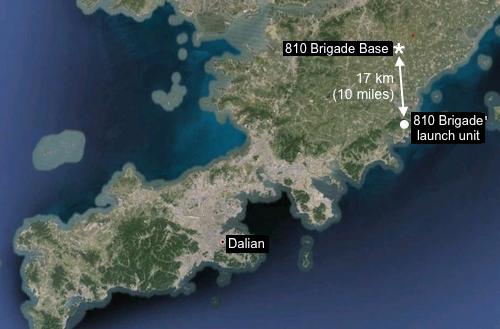
The 810 Brigade is based approximately 60 km (36 miles) northeast of Dalian, and the launch unit approximately 17 km (10 miles) south of the base.
The launch unit appears to be using a remote site with four launch pads for training approximately 17 km (10 miles) south of the brigade base. A new commercial satellite image, dated May 4, 2014, and made available by Digital Globe via Google Earth, shows significant upgrades at the site since 2006.
This includes construction of new launch pads that in shape and size appear to match those recently seen at the 807 Brigade base launch unit near Qingyang (Anhui) and the 802 Brigade base at Jianshui (Yunnan).
The satellite image is particularly interesting because it was taken on a day when the launch unit was using the site for a launch training exercise. Three of the four pads are in use with what appears to be DF-21 launchers deployed on the 45-meter paved strip and support vehicles near by. Other vehicles are positioned near the fourth launch pad (see image below).
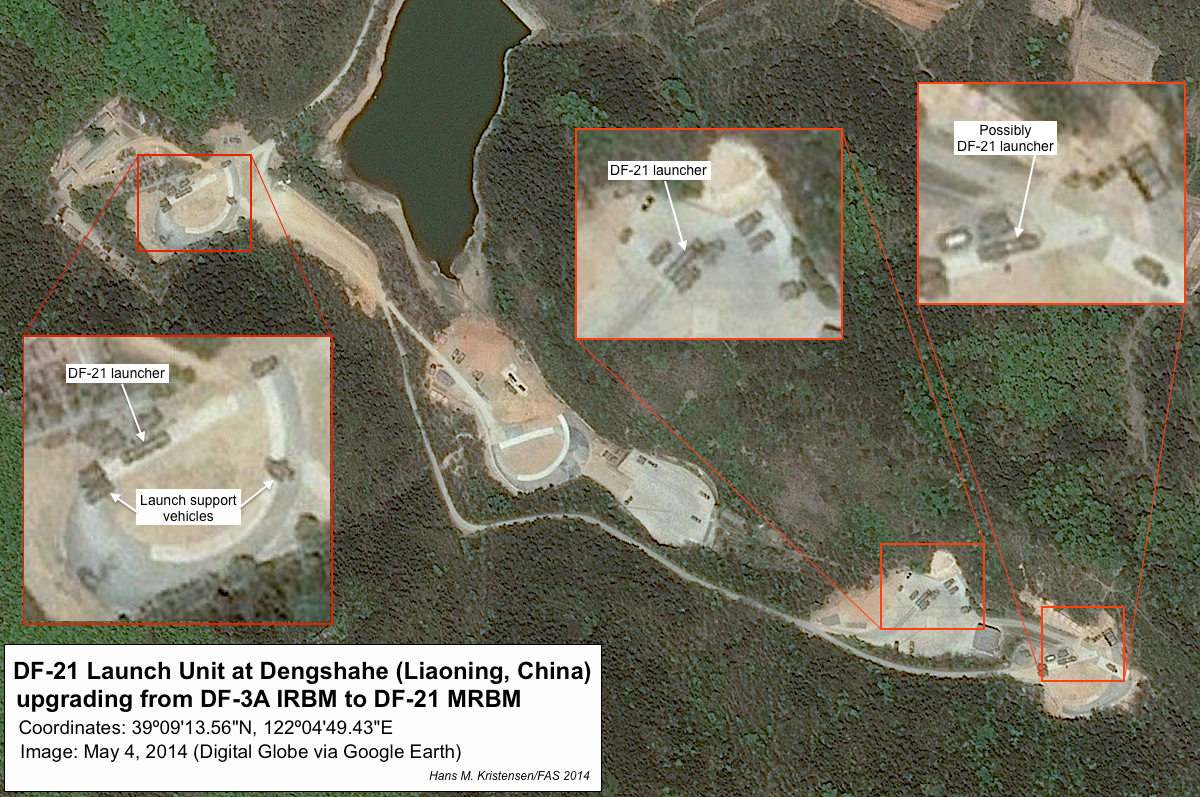
Four upgraded launch pads have been constructed at this launch unit site northeast of Dalian, possibly as part of conversion from DF-3A to DF-21 missiles. Click image for larger version.
The relatively poor quality of the high-resolution satellite image makes it hard to positively identify the launchers. But at approximately 14 meters (46 feet) they appear to match the nuclear DF-21 (CSS-5 Mod 1/Mod 2), which has a 10-11 meter (33-36 feet) missile canister on a trailer pulled by the motorized drivers section. The launchers do not appear to be the DF-21C, the conventional version, where the missile canister and drivers section are mounted on the same frame and the tip of the missile canister extends forward over the driver cabin (see here for images of such a unit).
A road-mobile launch unit has a large fingerprint because the launchers need a significant number of different support vehicles and personnel to operate. This includes command and control vehicles, cranes and other repair vehicles, trucks and busses. The Dengshahe launch unit image shows part of the large backup encamped immediately north of the launch pad sites (see image below).
Conversion to DF-21 at Dengshahe has been a long and slow process. DF-3A training levels dropped from five to eight months per year in the late-1980s to four months per year in the mid-1990s. Since then, the 810 Brigade shrunk to only five-ten launchers. The final phase has happened since 2006.
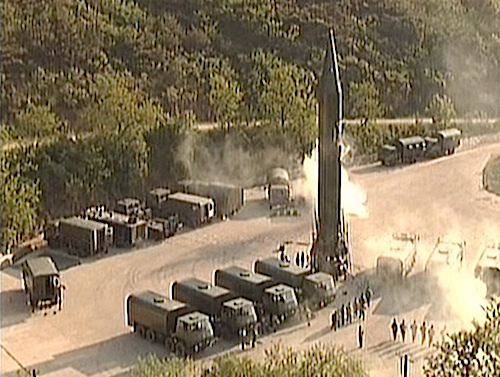
This unidentified picture of a DF-3A missile readied for launch with fuel trucks and other support vehicles might be from the second-most eastern launch pad at the Dengshahe site.
The range of the DF-21 is less than the range of the DF-3A (2,150 km versus 3,000 km), but the DF-21 system is much more capable than the DF-3A. Unlike the liquid-fuel, transportable DF-3A, the DF-21 is a solid-fuel missile carried on a road-mobile transporter erector launcher (TEL). As such, the DF-21 TEL can move around the landscape much more freely and can set up and fire its missile quicker than the DF-3A system. The DF-21 is also more accurate, which is reflected in a smaller warhead – 200-300 kilotons versus 3,300 kilotons for the DF-3A warhead.
From the launch pads north of Dalian, the DF-21 would able to target all U.S. military bases on the Japanese mainland as well as on Okinawa.

A DF-21 transporter erector launcher with the missile canister partially erected is surrounded by support vehicles.
The conversion from the DF-3A to the DF-21 is also reflected in significant reconstruction at the 810 Brigade base. Since 2006, this has included replacement of one of two high-bay garages with what are possibly garages for the DF-21 road-mobile launchers. A second high-bay garage has been significantly modified, and the support vehicle technical area has been upgraded (see image below).
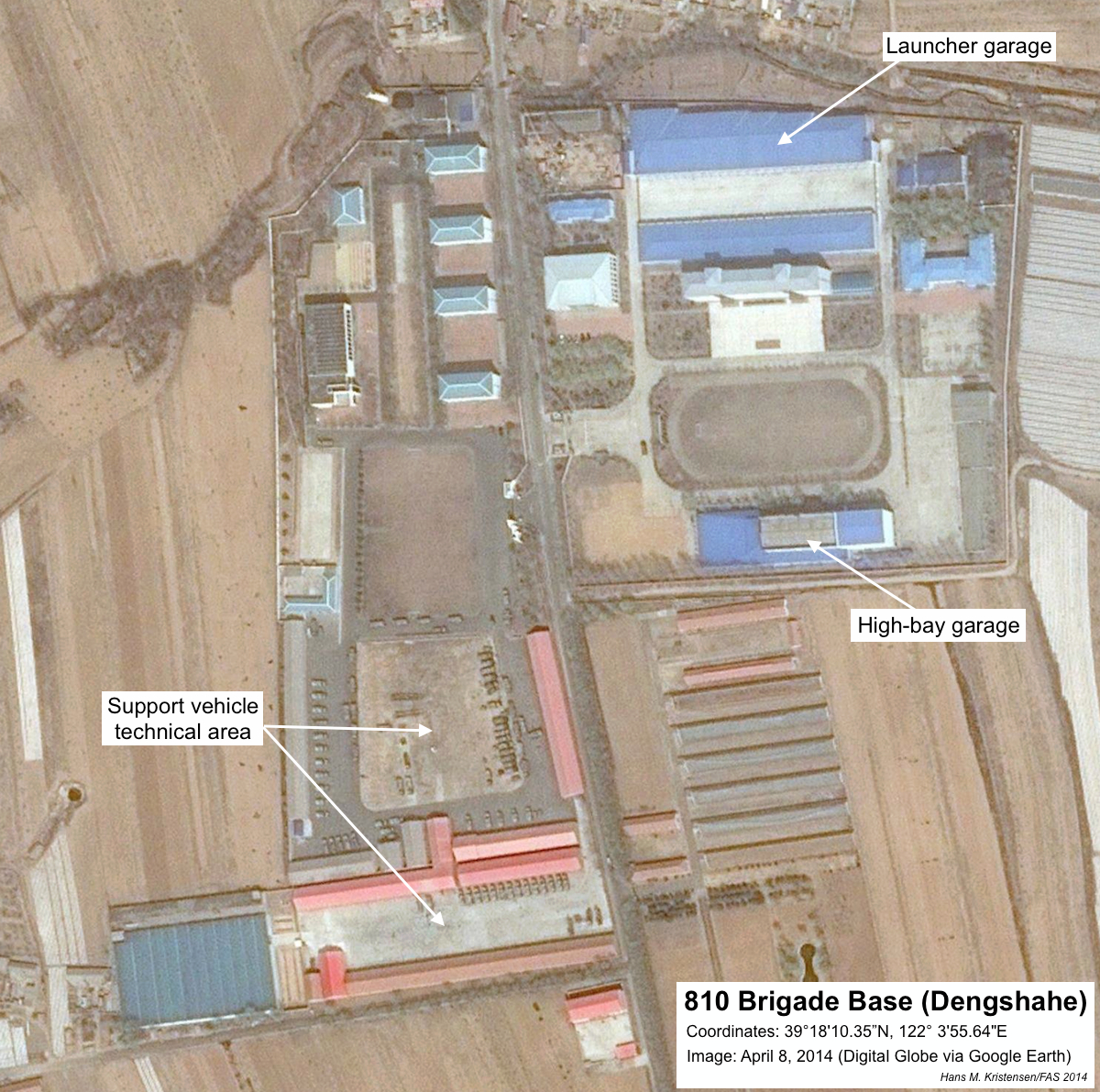
Since 2006, the 810 Brigade base at Dengshahe north of Dalian has been upgraded with possible DF-21 launcher garages and a modified high-bay garage for maintaining the launchers and missiles. Click image for larger version.
Background information: Chinese nuclear forces, 2013
Previous blogs about Chinese nuclear forces
This publication was made possible by a grant from the Ploughshares Fund. The statements made and views expressed are solely the responsibility of the author.
Nuclear Exercises Amidst Ukrainian Crisis: Time For Cooler Heads
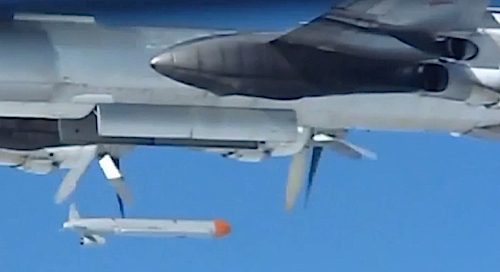
A Russian Tu-95MS long-range bomber drops an AS-15 Kent nuclear-capable cruise missiles from its bomb bay on May 8th. Six AS-15s were dropped from the bomb bay that day as part of a Russian nuclear strike exercise.
By Hans M. Kristensen
Less than a week after Russia carried out a nuclear strike exercise, the United States has begun its own annual nuclear strike exercise.
The exercises conducted by the world’s two largest nuclear-armed states come in the midst of the Ukraine crisis, as NATO and Russia appear to slide back down into a tit-for-tat posturing not seen since the Cold War.
Military posturing in Russia and NATO threaten to worsen the crisis and return Europe to an “us-and-them” adversarial relationship.
One good thing: the crisis so far has demonstrated the uselessness of the U.S. tactical nuclear weapons deployed in Europe.
Different Styles, Different Messages
Vladimir Putin’s televised commanding of the nuclear strike exercise – flanked by the presidents of Armenia, Belarus, Kyrgyzstan and Tajikistan in the Russian National Defense Command Center – made one thing very clear: Putin wanted to showcase his nuclear might to the world. Russian military news media showed the huge displays in the Command Center with the launch positions and impact areas of long-range nuclear missiles launched from a road-mobile launchers and ballistic missile submarines.

A map in the National Defense Command Center shows the launch points and impact areas of nuclear missiles launched across Russia. Click to see larger version.
Other displays and images on the Russian Internet showed AS-15 Kent (Kh-55) nuclear cruise missiles launched from a Tu-95 “Bear” bomber (six missiles were launched), short-range ballistic missiles, and air-defense and ballistic missile defense interceptors reportedly repelled a “massive rocket nuclear strike” launched against Russia by “a hypothetical opponent.”
Of course everything was said to work just perfectly but there is no way to known how well the Russian forces performed, how realistic the exercise was designed to be, or what was different compared with previous exercises. Russia conducts these exercises each year and Russian military planners love to launch a lot of rockets very quickly with lots of smoke and noise (it looks impressive on television). But the exercise looked more like a one-day snap intended to showcase test launching of offensive and defensive forces rather than a significant new development.
The STRATCOM announcement of the Global Lightning exercise was, in contrast, much more timid, so far limited to a single press release. Mindful of the problematic timing, the press release said the timing was “unrelated to real-world events” and that the exercise has been planned for more than a year. But some new stories nonetheless linked the two events.
The STRATCOM press release didn’t say much about the exercise scenario or what forces would be involved. Only bombers – whose operations are highly visible and would probably be noticed anyway – were mentioned: 10 B-52 and up to six B-2 bombers. But SSBNs and ICBMs also participate in Global Lightning (although not with live test launches as in the Russian exercise) as well as refueling tankers and command and control units.
As its main annual strategic nuclear command post/field training exercise, STRATCOM uses Global Lightning to verify the readiness and effectiveness of U.S. nuclear forces and practice strike scenarios from OPLAN 8010-12 and other war plans against potential adversaries. Last updated in June 2012, OPLAN 8010-12 is being adjusted to incorporate decisions from the Obama administration’s June 2013 nuclear weapons employment strategy.
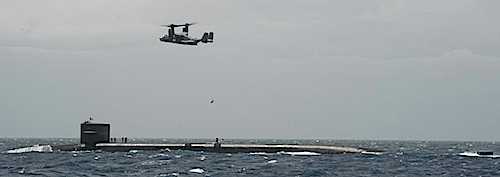
Although STRATCOM has only mentioned bombers participating in the Global Lightning 14 exercise, SSBNs and ICBMs also participate. This picture shows a V-22 Osprey delivering supplies to USS Louisiana (SSBN-424) during operations in the Pacific in 2012.
The previous Global Lightning exercise was held in 2012 (Global Lightning 2013 was canceled due to budget cuts) and is normally accompanied or followed by other nuclear-related exercises such as Global Thunder, Vigilant Shield, and Terminal Fury. In addition to strategic nuclear planning, STRATCOM supports regional nuclear targeting as well. The 2012 Global Lightning exercise supported Pacific Command’s Terminal Fury exercise in the Pacific and included several crisis and time-sensitive strike scenarios against extremely difficult target sets never seen before in Terminal Fury.
Back to Us and Them
One can read a lot into the exercises, if one really wants to. And some commentators have suggested that the exercises were deliberately intended as reminders to “the other side” of the Ukrainian crisis about the horrific military destructive power each side possesses.
I don’t think the Russian exercise or the U.S. Global Lightning exercise are directly linked to the Ukrainian crisis; they were planned long in advance. Nuclear weapons – and fortunately so – seem completely out of proportion to the circumstances of the situation in Ukraine.
Nonetheless, they do matter in the overall east-west sparing and the fact that the national leadership of Russia and the United States authorized these nuclear exercises at this particular time is a cause for concern. It is the first time nuclear forces have been rattled during the Ukrainian crisis. And because they are nuclear, the exercises add important weight to a pattern of increasingly militaristic behaviors on both sides.
Russia’s invasion of Crimea – bizarrely coinciding with Russia celebrating its defeat of a different invasion of the Soviet Union 73 years ago – to prevent loosing its Black Sea fleet area to an increasingly westerly looking Ukraine, and NATO responding by beefing up its military posture in Eastern Europe far from Ukraine to demonstrate “that NATO is prepared to meet and deter any threat to our alliance” – even though there are no signs of an increased Russian military threat against NATO territory in general – ought to have caused political leaders on both sides to delay the nuclear exercises to avoid fueling crisis sentiments and military posturing any further.
Instead, both sides now seem determined to stick to their guns and overturn the budding partnership and trust that had emerged after the Cold War. In doing so, the danger is, of course, that the military institutions on both sides are allowed to dominate the official responses to the crisis and deepen it rather than de-escalating and resolving it. No doubt, military hawks and defense contractors on both sides see an opportunity to use the Ukrainian crisis to get the defense budgets and weapons they have wanted for years but been unable to get because of budget cuts and the absence of a significant military “threat.”
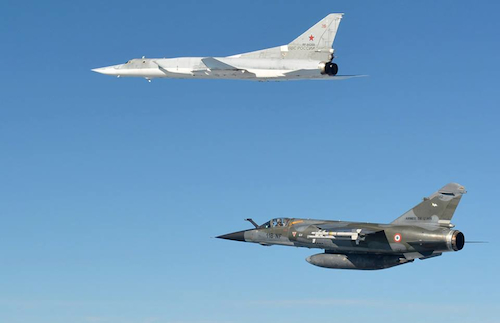
A French Mirage follows a Russian Tu-22M3 Backfire bomber over the Baltic Sea in June 2013. Three months earlier, two Russian Tu-22M3s escorted by four Su-27 Flanker fighters simulated a nuclear attack on two targets in Sweden.
Russia has already announced plans to add 30 warships to the Black Sea Fleet and widen deployment of navy and air forces to four additional bases in Crimea.
The Russian air force has resumed long-range training flights with nuclear aircraft and often violates the air space of other countries. In March 2013, two Tu-22M3 backfire bombers reportedly simulated a nuclear strike against two targets in Sweden (although the aircraft did not violate Swedish air space at that time).
It is almost inevitable that increased NATO deployments and defense budgets in eastern member countries will trigger Russian military counter-steps closer to NATO borders. One of the first tell signs will be the Zapad exercise later this fall.
For its part, NATO has already deployed ships, aircraft, and troops to Eastern European countries and is considering how to further change its defense planning to respond with “air, land and sea ’reassurances’” to “a different paradigm, a different rule set” (translation: Russia is now an official military threat), according to NATO’s military commander General Philip Breedlove and “position those ‘reassurances’ across the breadth of our exposure: north, center, and south.”
NATO General Secretary Anders Fogh Rasmussen echoed Breedlove’s defense vision during a visit to Estonia on May 1st, saying the Ukrainian crisis had triggered a NATO response where “aircraft and ships from across the Alliance are reinforcing the security from the Baltic to the Black Sea.”
Breedlove and Rasmussen paint a military response that appears to go beyond the Ukrainian crisis itself and involve a broad reinforcement of NATO’s eastern areas. Breedlove got NATO approval for the initial deployments and exercises seen in recent weeks, but the defense ministers meeting in Brussels in June likely will prepare more fundamental changes to NATO military posture for approval at the NATO Summit in Wales in September.
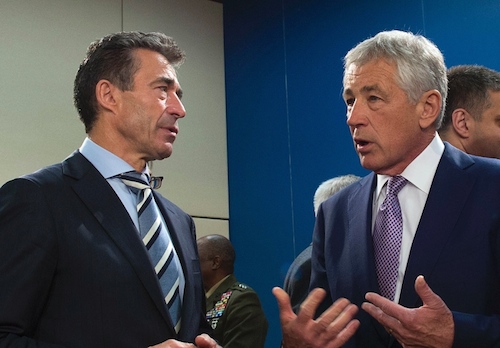
General Secretary Anders Fogh Rasmussen and other NATO officials describe a broad military reinforcement across NATO in response to Russia’s invasion of Ukraine, which U.S. Defense Secretary Chuck Hagel says requires NATO countries to increase their defense budgets.
Among other aspects, those changes will probably involve modifying NATO’s General Intelligence Estimate (MC 161) and NATO Ministerial Guidance to explicitly identify Russia, once again, as a potential threat. Doing so will open the door for more specific Article 5 contingency plans for the defense of eastern European NATO countries.
In reality, the military responses to the Ukraine crisis include many efforts that have been underway within NATO since 2008. The Baltic States and Poland have been urging NATO to draw up contingency plans for the defense of Eastern Europe against Russian incursions or military attack. Two obstacles worked against this: declining defense budgets (who’s going to pay for it?) and a reluctance to officially declare Russia to be a military threat to NATO. The latter obstacle is now gone and U.S. Defense Secretary Chuck Hagel’s is now publicly using the Ukraine crisis to ask NATO countries to increase their defense budgets.
After a decade of depleting its declining resources on an costly, open-ended war in Afghanistan that it cannot win, the Ukrainian crisis seems to have given NATO a sense of new purpose: a return to its core mission of defending NATO territory. “Russia’s actions in Ukraine have made NATO’s value abundantly clear,” Hagel said earlier this month, “and I know from my frequent conversations with NATO defense ministers that they do not need any convincing on this point.”
But one of the biggest obstacles to increasing defense budgets, Hagel said, “has been a sense that the end of the Cold War ushered in the ‘end of history’ – an end to insecurity, at least in Europe and the end [of] aggression by nation states. But Russia’s action in Ukraine shatter that myth and usher in bracing new realities,” he concluded, and “over the long term, we should expect Russia to test our alliance’s purpose, stamina, and commitment.”
In other words, it’s back to us and them.
It is difficult to dismiss Eastern European jitters about Russia – after all, they were occupied by the Soviet Union and joined NATO specifically to get the security guarantee so never to be occupied again. And Russia’s unlawful annexation of Crimea has completely shattered its former status as a European partner.
But the big question is whether NATO responding to Ukraine by beefing up its military inadvertently plays into the hands of Russian hardliners and will serve to deepen rather than easing military competition in Europe.
Why the Putin regime would respond favorably to NATO increasing its military posture in Eastern Europe is not clear. Yet it seems inconceivable that NATO could chose not to do so; after all, providing military protection is the core purpose of the Alliance.
At the same time, the more they two sides posture to demonstrate their resolve or unity, the harder it will be for them to de-escalate the crisis and rebuild the trust. Remember, we’ve been down that road and it took us six decades to get out.
Rather, it seems more likely that beefing up military forces and operations will reaffirm, in the eyes of Russian policy makers and military planners, what they have already decided; that NATO is a threat that is trying to encroach Russia who therefore must protect its borders and secure a sphere of influence as a buffer. Georgy Bovt’s recent analysis in Moscow Times of the Russian mindset is worthwhile reading.
The Irrelevance of Tactical Nuclear Weapons
So what does all of that mean for nuclear weapon in Europe? Remember, they’re supposed to reassure the NATO allies!
I hear many say that the Ukrainian crisis makes it very difficult to imagine a reduction, much less a withdrawal, of U.S. non-strategic nuclear weapons from Europe. Some people have even argued that the Ukrainian crisis could have been avoided if Ukraine had kept the nuclear weapons the Soviet Union left behind when it crumbled in 1991 (the argument ignores that Ukraine didn’t have the keys to use the weapons and would have been isolated as a nuclear rogue if it had not handed them over).
Only two years ago, NATO rejected calls for a withdrawal of U.S. nuclear weapons from Europe based on the argument that the deployment continues to serve an important role as a symbol of the U.S. security commitment to Europe and because eastern European NATO countries wanted the weapons in Europe to be assured about their protection against Russia. The May 2012 Defense and Deterrence Posture Review (DDPR), implementing the Strategic Concept from 2010, reaffirmed status quo by concluding “that the Alliance’s nuclear force posture currently meets the criteria for an effective deterrence and defense posture.”
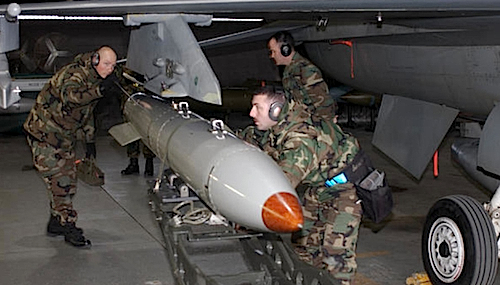
A B61 nuclear bomb trainer is loaded onto an F-16 somewhere in Europe, probably at Aviano Air Base in Italy. Some Eastern European NATO allies argue that the nuclear weapons provide important reassurance, but request deployment additional non-nuclear assets to deter Russia.
Yet here we are, only two years later, where the nuclear weapons have proven absolutely useless in reassuring the allies in the most serious crisis since the Cold War. Indeed, it is hard to think of a stronger reaffirmation of the impotence and irrelevance of tactical nuclear weapons to Europe’s security challenges than NATO’s decision to deploy conventional forces and beef up conventional contingency planning and defense budgets in response to Russia’s invasion of Ukraine and annexation of Crimea.
Put in another way, if the U.S. nuclear deployment was adequate for an effective deterrence and defense posture, why is it now inadequate to assure the allies?
In fact, one can argue with some validity that spending hundreds of millions of dollars on maintaining U.S. non-strategic nuclear weapons in Europe after the end of the Cold War has done very little for NATO security, except wasting resources on a nuclear capability that is useless rather than spending the money on conventional capabilities that can be used. It is about fake versus real assurances.
The deployment of U.S. nuclear weapons in Europe seems to be for academic and doctrinal discourses rather than for real security. In the real world they don’t seem to matter much and seem downright useless for the kinds of security challenges facing NATO countries today. But try telling that to current and former officials who have been spending the past five years lobbying and educating Eastern NATO governments on why the weapons should stay.
This publication was made possible by a grant from the Ploughshares Fund. The statements made and views expressed are solely the responsibility of the author.
Russian ICBM Force Modernization: Arms Control Please!
By Hans M. Kristensen
In our Nuclear Notebook on Russian nuclear forces from March this year, Robert S. Norris and I described the significant upgrade that’s underway in Russia’s force of land-based intercontinental ballistic missiles (ICBMs).
Over the next decade, all Soviet-era ICBMs will be retired and replaced with a smaller force consisting of mainly five variants of one missile: the SS-27.
After more than a decade-and-a-half of introduction, the number of SS-27s now makes up a third of the ICBM force. By 2016, SS-27s will make up more than half of the force, and by 2024 all the Soviet-era ICBMs will be gone.
The new force will be smaller and carry fewer nuclear warheads than the old, but a greater portion of the remaining warheads will be on missiles carried on mobile launchers.
The big unknowns are just how many SS-27s Russia plans to produce and deploy, and how many new (RS-26 and Sarmat “heavy”) ICBMs will be introduced. Without the new systems or increased production of the old, Russia’s ICBM force would probably level out just below 250 missiles by 2024. In comparison, the U.S. Air Force plans to retain 400 ICBMs.
This disparity and the existence of a large U.S. reserve of extra warheads that can be “uploaded” onto deployed missiles to increase the arsenal if necessary drive top-heavy ICBM planning in the Russian military which seeks to maximize the number of warheads on each missile to compensate for the disparity and keep some degree of overall parity with the United States.
This dilemma suggests the importance of reaching a new agreement to reduce the number deployed strategic warheads and missiles. A reduction of “up to one-third” of the current force, as recently endorsed by the new U.S. nuclear employment strategy, would be a win for both Russia and the United States. It would allow both countries to trim excess nuclear capacity and save billions of dollars in the process.
Phased Deployment
Introduction of the SS-27 has come in two phases. The first phase, which last from 1997 to 2013, involved deployed the single-warhead type (SS-27 Mod 1; Topol-M) in silos and on road-mobile launchers. The silo-based version was deployed first, replacing SS-19s in the 60th Missile Division at the Tatishchevo missile field outside Saratov. The deployment was completed in 2013 (see picture below) after 60 SS-27 Mod 1 missiles had been lowered into former SS-19 silos at a slow pace of less than 4 missile in average per year.
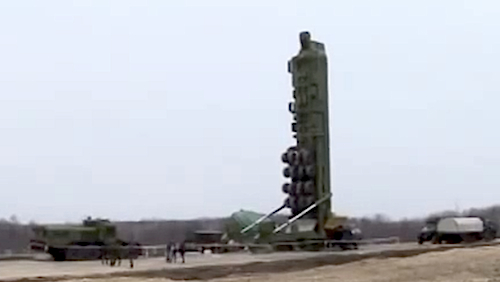
An SS-27 Mod 1 (Topol-M) is lowered into a former SS-19 silo at the Tatishchevo missile field outside Saratov.
In 2006, deployment of the first road-mobile SS-27 Mod 1 began with the 54th Guards Missile Division at Teykovo northeast of Moscow. The deployment was completed in 2010 with 18 missiles in two regiments.
With completion of the SS-27 Mod 1 deployment of 78 missiles, efforts have since shifted to deployment of a MIRVed version of the SS-27, known as SS-27 Mod 2, or RS-24 Yars in Russia. It is essentially the same missile as the Mod 1 version except the payload “bus” has been modified to carry multiple independently targetable warheads (MIRV). Each missile is thought to be able to carry up to 4 warheads, although there is uncertainty about what the maximum capacity is (but it is not 10 warheads, as often claimed in Russian news media).
The first road-mobile SS-27 Mod 2s were deployed at Teykovo in 2010, alongside the SS-27 Mod 1s already deployed there. For the foreseeable future, all new Russian ICBM deployments will be of MIRVed versions of the SS-27, although a “new ICBM” and a “heavy ICBM” are also being developed.
In 2012, preparations began for introduction of SS-27 Mod 2 at three additional missile divisions. At the 28th Missile Guards Division at Kozelsk southwest of Moscow, conversion of former SS-19 silos (see picture below) to carry the SS-27 Mod 2 is underway with deployed of the first regiment (10 missiles) scheduled this year. How many missiles will be deployed at Kozelsk is unclear. The missile field originally included 60 SS-19 silos but half have been demolished so perhaps the plan is for three regiments with 30 SS-27 Mod 2 missiles. After silo-based RS-24s are installed at Kozelsk, deployment will follow at the 13th Missile Division at Dombarovsky, replacing the SS-18s currently deployed there.

A former SS-19 ICBM silo at Kozelsk is being upgraded to receive the SS-27 Mod 2 (RS-24 Yars) ICBM. Deployment begins this year.
In addition to Kozelsk, preparations are also underway to upgrade three road-mobile SS-25 garrisons to the SS-27 Mod 2. At this point, this includes the 51st Missile Guards Division at Irkutsk, the 39th Guards Missile Division at Novosibirsk, and the 42nd Missile Division at Nizhniy Tagil.
Preparation started at Novosibirsk in 2012, where two of four garrisons are under conversion. One of these (Novosibirsk 4; see further description below) is nearly complete. Conversion started at Irkutsk in 2012 with dismantling of SS-25 garages at one of the three remaining garrisons. At Tagil, SS-27 Mod 2 introduction is underway at two of three remaining SS-25 garrisons. In December 2013, the first SS-27 Mod 2 regiment at Novosibirsk (9 launchers) and one partially equipped (6 launchers) regiment at Tagil were put on “experimental combat duty.”
The remaining SS-25 divisions – the 7th Guards Missile Division at Vypolsovo, the 14th Missile Division at Yoshkar-Ola, and the 35th Missile Division at Barnaul – have not been mentioned for SS-27 Mod 2 upgrade and seem destined for retirement. One of the three garrisons at Yoshkar-Ola has been inactivated.
Below follows a more detailed description of the upgrade to SS-27 Mod 2 (RS-24) underway at Novosibirsk.
SS-27 Upgrade at Novosibirsk
As mentioned above, the 39th Guards Missile Division at Novosibirsk is being upgraded from the solid-fuel road-mobile single-warhead SS-25 ICBM to the solid-fuel road-mobile MIRVed SS-27 Mod 2 (RS-24). A series of unique satellite images provided by Digital Globe to Google Earth show the upgrade of one of four garrisons (Novosibirsk 4) between 2008 and 2013.
The first image from May 2008 (see below) shows the garrison with all nine garages for SS-25 road-mobile launchers (TELs) clearly visible inside the multi-layered fence perimeter. Several TELs and support vehicles are parked outside one of three service buildings.
The second image from June 2012 (see below) shows that all nine TEL garages have been dismantled and the roof is missing on the three service vehicle buildings. Two new service buildings are under construction just outside the fence perimeter and several buildings have been demolished in preparation for new administrative and technical buildings.
The third image, taken in February 2013, shows the fence perimeter at the southwest corner of the garrison has been extended westward to include the new service buildings. This extension is similar to the change that was made at Teykovo when two garrisons were equipped with the SS-27 Mod 2 (RS-24). The image indicates that support vehicle garages inside the fence perimeter are almost done, and that administrative and technical buildings outside the perimeter have been added.
The fourth image (see below), from September 2013, shows installation of new TEL garages for the SS-27 Mod 2 (RS-24) launchers well underway, with seven of eventually nine garages visible. The green roofs of the four large service vehicle garages are clearly visible, as are the new administrative and technical building outside the fence perimeter.
The Future ICBM Force
Predicting the size and composition of the Russian ICBM force structure into the future comes with a fair amount of uncertainty because Russia doesn’t release official data on its nuclear forces, because U.S. intelligence agencies no longer publish detailed information on Russian nuclear forces, and because Russian aggregate data under the New START treaty is not made public (unlike during the previous START treaty). Nonetheless, based on previous history, scattered officials statements, and news media reports, it is possible to make a rough projection of how the Russian ICBM might evolve over the next decade (see graph below).
This shows that the size of the Russian ICBM force dropped below the size of the U.S. ICBM force in 2007 mainly due to the rapid reduction of the SS-25 ICBM. By the early 2020s, according to recent announcements by Russian military officials, all SS-18, SS-19, and SS-25 ICBMs will be gone. Development of a new ICBM – apparently yet another version of the SS-27 – known in Russia as the RS-26 is underway for possible introduction in 2015. And a new liquid-fuel “heavy” ICBM known in Russia as the Sarmat, and nicknamed “Son of Satan” because it apparently is intended as a replacement for the SS-18 (which was code-named Satan by the United States and NATO) is said to be scheduled for introduction around 2020.
This development would leave a Russian ICBM force structure based on five modifications of the solid-fuel SS-27 (silo- and mobile-based SS-27 Mod 1; silo- and mobile-based SS-27 Mod 2 (RS-24); and the RS-26) and the liquid-fuel Sarmat with a large payload – either MIRV or some advanced payload to evade missile defense systems. Although the future force will be smaller, a greater portion of it will be MIRVed – up from approximately 36 percent today to roughly 70 percent by 2024. This increasingly top-heavy ICBM force is bad for U.S-Russian strategic stability.
I hope I’m mistaken about the possible increase in the Russian ICBM force after 2020. In fact, it seems more likely that the Russian economy will not be able to support the production and deployment of “over 400 modern land and sea-based inter-continental ballistic missiles” that President Putin promised in 2012. But if I’m not mistaken, then it would be an immensely important development. Not that I think it would matter that much militarily in the foreseeable future or necessarily signal a new arms race. But it would be a significant break with the trend we have seen in Russian nuclear forces since the end of the Cold War, and it would create serious problems for the stability of the Non-Proliferation Treaty regime. It is important that the Russian government provides more transparency about its nuclear force structure plans and demonstrate that it is not planning to increase its ICBM force shortly after the New START treaty expires in 2018.
Regardless, there is an increasing need for Russia and the United States to make more progress on nuclear arms control. Notwithstanding its important verification regime, the New START treaty was too modest to impress anyone (it has no real effect on Russian nuclear forces and it is so modest that the United States plans to keep emptied ICBM silos instead of destroying them). A good start would be a new arms control agreement with “up to one-third” fewer deployed strategic warheads and launchers than permitted by the New START Treaty, as recently endorsed by the U.S. Nuclear Employment Strategy. Such an agreement would force Russia to reduce the warhead loading on its ICBMs and force the United States to reduce its large ICBM force.
It is also important that the United States and Russia revisit the MIRV-ban. The START II treaty, which was signed but not ratified and later abandoned by Vladimir Putin and George W. Bush in 2002, included a ban on MIRVed ICBMs. Apart from reducing the warheads the two nuclear superpowers would be able to launch agains each other, a MIRV ban would also serve the vital role of discouraging other nuclear-armed states from deploying multiple warheads on their ballistic missiles in the future, which could otherwise significantly increase their nuclear arsenals and result in regional arms races.
Trying to pursue new reductions in excessive and expensive nuclear forces and avoid counterproductive modernization programs is perhaps even more important now given the souring relations caused by the crisis in Ukraine. Don’t forget: even at the height of the Cold War it was possible – in fact essential – to reach nuclear arms control agreements.
Additional background: Russian Nuclear Forces, 2014 | Russian SSBN Fleet
This publication was made possible by a grant from the Ploughshares Fund. The statements made and views expressed are solely the responsibility of the author.
Nuclear Modernization Briefings at the NPT Conference in New York

By Hans M. Kristensen
Last week I was in New York to brief two panels at the Third Session of the Preparatory Committee for the 2015 Review Conference of the Parties to the Treaty on the Non-Proliferation of Nuclear Weapons (phew).
The first panel was on “Current Status of Rebuilding and Modernizing the United States Warheads and Nuclear Weapons Complex,” an NGO side event organized on May 1st by the Alliance for Nuclear Accountability and the Women’s International League for Peace and Freedom (WILPF). While describing the U.S. programs, I got permission from the organizers to cover the modernization programs of all the nuclear-armed states. Quite a mouthful but it puts the U.S. efforts better in context and shows that nuclear weapon modernization is global challenge for the NPT.
The second panel was on “The Future of the B61: Perspectives From the United States and Europe.” This GNO side event was organized by the Nuclear Age Peace Foundation on May 2nd. In my briefing I focused on providing factual information about the status and details of the B61 life-extension program, which more than a simple life-extension will produce the first guided, standoff nuclear bomb in the U.S. inventory, and significantly enhance NATO’s nuclear posture in Europe.
The two NGO side events were two of dozens organized by NGOs, in addition to the more official side events organized by governments and international organizations.
The 2014 PREPCOM is also the event where the United States last week disclosed that the U.S. nuclear weapons stockpile has only shrunk by 309 warheads since 2009, far less than what many people had anticipated given Barack Obama’s speeches about “dramatic” and “bold” reductions and promises to “put an end to Cold War thinking.”
Yet in disclosing the size and history of its nuclear weapons stockpile and how many nuclear warheads have been dismantled each year, the United States has done something that no other nuclear-armed state has ever done, but all of them should do. Without such transparency, modernizations create mistrust, rumors, exaggerations, and worst-case planning that fuel larger-than-necessary defense spending and undermine everyone’s security.
For the 185 non-nuclear weapon states that have signed on to the NPT and renounced nuclear weapons in return of the promise made by the five nuclear-weapons states party to the treaty (China, France, Russia, United Kingdom, and the United States) “to pursue negotiations in good faith on effective measures relating to the cessation of the nuclear arms race at early date and to nuclear disarmament,” endless modernization of the nuclear forces by those same five nuclear weapons-states obviously calls into question their intension to fulfill the promise they made 45 years ago. Some of the nuclear modernizations underway are officially described as intended to operate into the 2080s – further into the future than the NPT and the nuclear era have lasted so far.
Download two briefings listed above: briefing 1 | briefing 2
This publication was made possible by a grant from the Ploughshares Fund. The statements made and views expressed are solely the responsibility of the author.
US Nuclear Weapons Stockpile Number Declassified: Only 309 Warheads Cut By Obama Administration
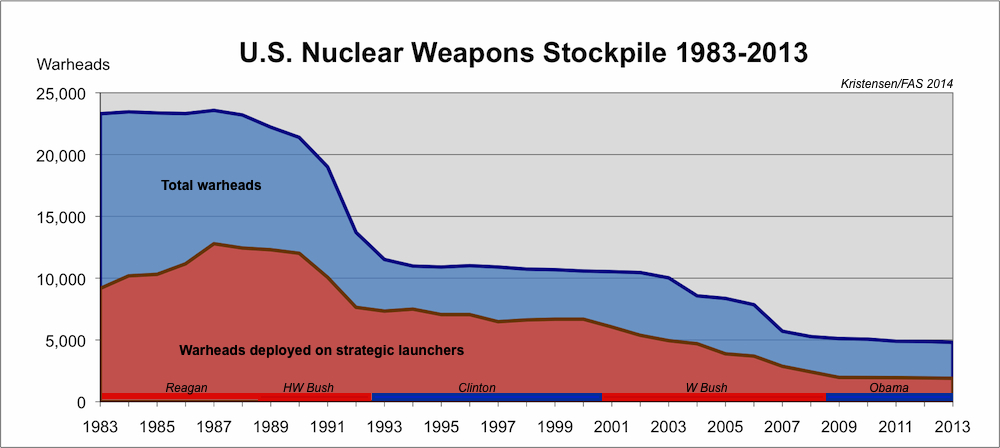
The Obama administration has yet to make a visible dent in the U.S. nuclear weapons stockpile. Click on graph for larger format.
By Hans M. Kristensen
After a transparency hiatus of four years, the Obama administration has declassified the size of its nuclear weapons stockpile: 4,804 warheads as of September 2013.
The new stockpile size is 309 warheads fewer than the 5,113 warheads that the administration in 2010 reported were in the stockpile as of September 2009.
The new number of 4,804 warheads is 154 warheads more than Norris and I have in our latest Nuclear Notebook, in which we estimated a stockpile of 4,650 warheads. That estimate was, in part, based on the statement by Donald Cook, the NNSA administrator for defense programs, who in an email in February 2013 informed us that the reduction had been “approximately 85%” since 1967.
The new State Department announcement also mentions the “85 percent reduction,” although the 4,804 warheads actually correspond to a reduction of approximately 84 percent from the peak of 31,255 warheads in 1967. We thought 154 additional warheads had been retired, but apparently that will take a little longer.
What the declassification does not include, unfortunately, is a number for how many retired warheads are awaiting dismantlement. That number includes “several thousand” warheads, according to the fact sheet; we estimate approximately 2,500.
Timing is Everything
The declassification is timed with the opening in New York of the third preparatory committee meeting for the Nuclear Non-Proliferation Treaty. As a declared nuclear-weapon state party to the treaty, the United States needs to be able to demonstrate that it is living up to its obligations under the treaty’s Article VI to “pursue negotiations in good faith on effective measures relating to cessation of the nuclear arms race at an early date….”
Since President Barack Obama took office in 2009, the record shows the United States has:
* Reduced the nuclear stockpile by 309 warheads (roughly equivalent to the size of the entire French nuclear stockpile);
* Dismantled 1,204 retired warheads (more than the nuclear weapons inventories of France, China, Britain, Pakistan, India, Israel, and North Korea combined);
* Negotiated and signed the New START Treaty, limiting U.S. and Russian deployed strategic warheads to 1,550 by 2018, down from the 2,200 limit of the 2002 Moscow Treaty.
For the other nuclear-weapon states that have signed the NPT (Britain, China, France, and Russia) Britain and France have disclosed some stockpile numbers, although they were single year numbers and not the stockpile history like that of the United States. Both should disclose more complete histories of their nuclear stockpiles and dismantlements.
China and Russia have not disclosed anything but need to become more transparent about their stockpiles.
Implications
It is good to see that the administration has decided to declassify the stockpile and dismantlement numbers after 2009. It provides and official record that the United States is making progress (although slowly) in reducing its inventory of nuclear warheads.
Yet only 309 warheads fewer in four years! Not exactly the “dramatic” reductions promised by Barack Obama during the 2008 election campaign.
In fact, the numbers demonstrate one, for the Obama administration, uncomfortable fact: it has yet to make a noticeable dent in the stockpile. Big stockpile reductions over the past 30 years have all happened during Republican presidents (see table above). Although the Clinton administration dismantled over 11,000 retired nuclear warheads, it did not make significant reductions in the remaining stockpile or the number of warheads deployed on launchers. After the W Bush administration cut the stockpile nearly in half and offloaded more than half of the warheads deployed on strategic launchers, the Obama administration’s policies so far have had only a modest effect on the size of the stockpile and the number of warheads deployed on strategic launchers.
One reason is that the Obama administration has been opposed by a Republican Congress that has fought against nuclear reductions. But it is also because the administration itself has reaffirmed long-standing nuclear policy, protected the force structure, and emphasized modernizations of nuclear forces.
One would hope that the administration during its final four years would be bolder and seek to implement more reductions without Congressional approval of a new treaty. Clearly, much more can be done. Russia is already well below the New START limits and its nuclear forces are expected to decline further even without a follow-on treaty. Both Russia and the United States need to cut defense spending and both still have nuclear arsenals that are vastly in excess of national security needs.
China SSBN Fleet Getting Ready – But For What?
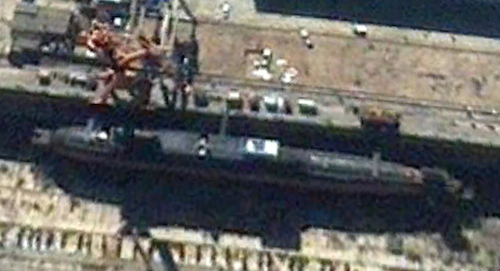 By Hans M. Kristensen
By Hans M. Kristensen
China’s emerging fleet of 3-4 new Jin-class nuclear-powered ballistic missile submarines is getting ready to deploy on deterrent patrols, “probably before the end of 2014,” according to U.S. Pacific Command.
A new satellite image taken in October 2013 (above) shows a Jin SSBN in dry dock at the Bohai shipyard in Huludao. Two of the submarine’s 12 missile tubes are open. It is unclear if the submarine in the picture is the fourth boat or one of the first three Jin SSBNs that has returned to dry dock for repairs or maintenance.
The U.S. intelligence community predicts that “up to five [Jin-class (Type 094) SSBNs] may enter service before China proceeds to its generation SSBN (Type 096) over the next decade,” an indication that the noisy Jin-class design might already be seen as outdated.
This and numerous other commercial satellite images (see below) show how China over the past decade has built an infrastructure of naval facilities to service the new SSBN fleet. This includes upgrades at naval bases, submarine hull demagnetization facilities, underground facilities and high-bay buildings for missile storage and handling, and covered tunnels and railways to conceal the activities from prying eyes in the sky.
Apart from how many Jin SSBNs China will build, the big question is whether the Chinese government will choose to operate them the way Western nuclear-armed states have operated their SSBNs for decades – deployed continuously at sea with nuclear warheads on the ballistic missiles – or continue China’s long-held policy of not deploying nuclear weapons outside Chinese territory but keeping them in central storage for deployment in a crisis.
Nuclear Submarine Sightings
Over the past decade, a total of 25 commercial satellite images made available on Google Earth have provided visual confirmation and information about the status and location of the Jin SSBNs (see table below). They show the submarines at four sites: the Bohai shipyard at Huludao on the Bohai Sea where the submarines are built; the Xiaopingdao naval base near Dalian where the submarines are fitted out for missile launch tests; the North Sea Fleet base at Jianggezhuang near Qingdao where one Jin SSBN is homeported along with the old Xia-class SSBN from the 1980s; and at the South Sea Fleet base at Longpo on Hainan Island where at least one Jin SSBN has been based since 2008.
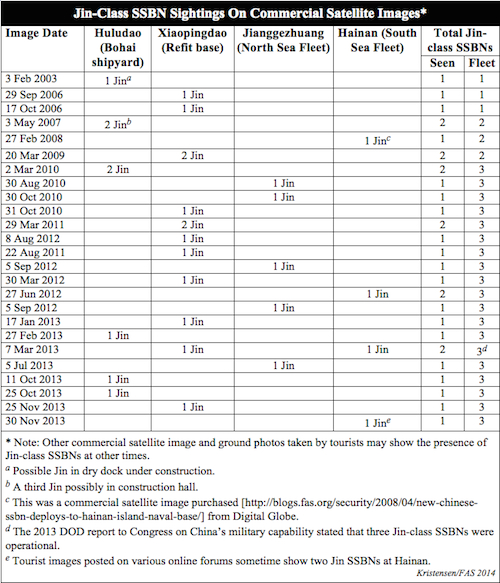
Bohai Ship Yard
The Bohai shipyard at Huludao builds China’s nuclear-powered submarines. The shipyard, which is located in the north of the Bohai Sea, is immensely busy with numerous large tankers and cargo ships under construction at any time. The submarine hulls are assembled in a large 40,000-squaremeter construction hall at the western end of the shipyard, rolled across a storage area into a dry dock for completion, and then launched into the harbor where they spend years tied up to a pier fitting out until handed over to the Chinese navy (PLAN).
Commercial satellite photos provide snapshots of the status of submarine construction and the quality is good enough to differentiate different submarine types and identify design details such as dimensions and layout of the missile compartment. One of the most recent photos (see below) shows a Jin-class SSBN in dry dock with two of 12 missile tubes open. Additional unassembled submarine hull sections are laid out on the ground next to the assembly hall.

The busy Bohai shipyard mixes nuclear submarine construction with commercial tankers and cargo ships in half a dozen dry docks. In this composite image from October 11 and 25, 2013, a completed Jin-class SSBN can be seen in dry dock and what appear to be hull sections for another submarine awaiting assembly. Click for large version.
In addition to satellite photos, tourists also occasionally take photos and post them on Google Panoramio or other web site. One such photo (see below) shows most of the shipyard with other overlaid photos showing dry dock cranes and two missile submarines first seen in 2007.
Xiaopingdao Submarine Refit Base
After completing construction at the Bohai shipyard the submarines sail to the Xiaopingdao refit base near Dalian. This base is used to prepare the submarines for operational service and is where test missiles are loaded into the launch tubes for test launches from the Bohai Sea across China into the Qinghai desert. Xiaopingdao is also used by China’s single Golf-class SSB, a special design submarine previously used to test launch SLBMs.
The base has been upgraded several times over the past decade-and-a-half including an extended pier to service the larger Jin-class SSBNs.
On two occasions, in March 2009 and March 2011, two Jin SSBNs have been seen docked at Xiaopingdao at the same time.
Xiaopingdao is also where the first Jin-class SSBN was spotted on a commercial satellite photo in July 2007.
Jianggezhuang (Laoshan) Submarine Base
The oldest nuclear submarine base is the North Sea Fleet base at Jianggezhuang (Laoshan) approximately 18 kilometers (11 miles) east of Qingdao in the Shandong province.
The Jin-class SSBN was first seen at Jianggezhuang on a commercial satellite image in August 2010.
The base is also home to the old Xia-class SSBN, the lone unit of China’s first experiment with ballistic missile submarines. The Xia completed a multi-year dry dock overhaul in 2007 but has probably never been fully operational and has never conducted a deterrent patrol.
This base is where we in 2006 spotted the long-rumored submarine cave, also described in Imaging Notes. The cave has a large water tunnel with access from the harbor and three land-tunnels providing access from various base facilities.
A satellite image from July 2013 (see below) shows both the Xia and a Jin SSBN at the base, with the Xia being assisted by two tugboats. Water turbulence behind the submarine indicates the Xia’s engine is operational.
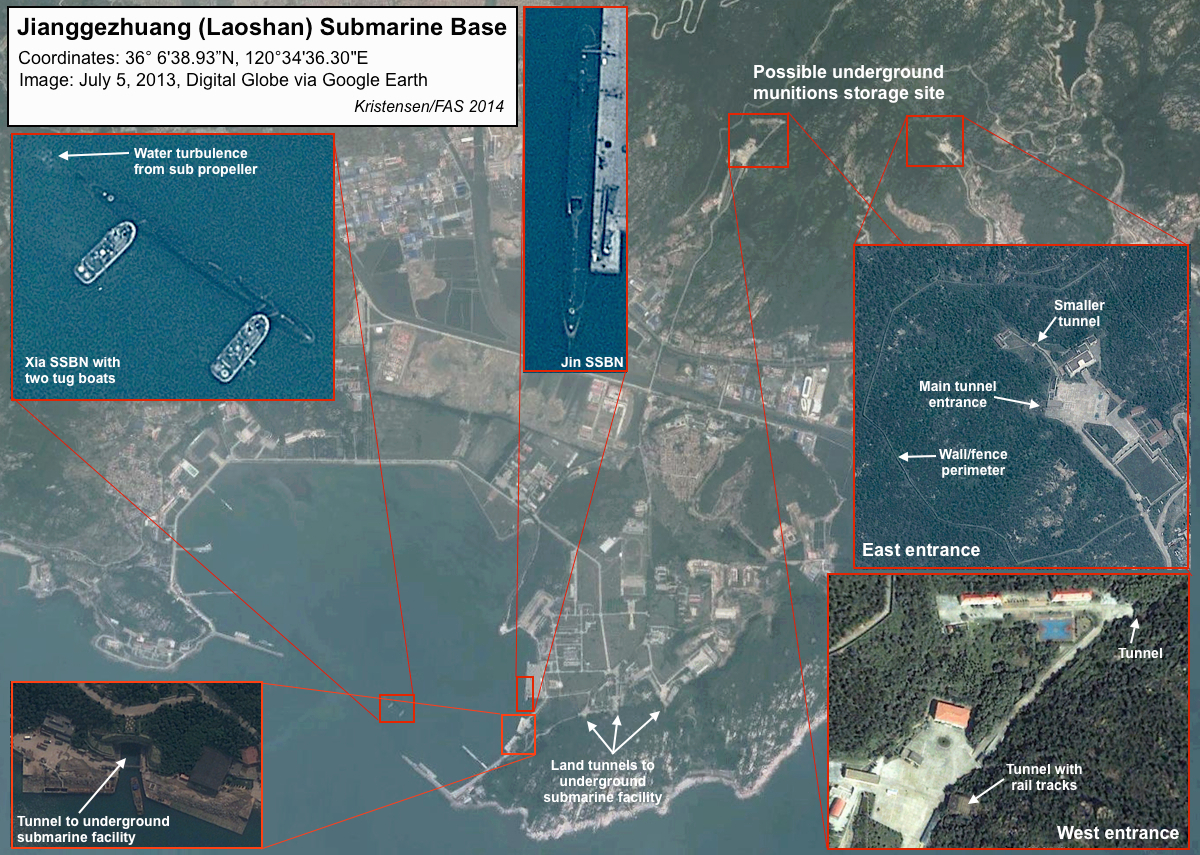
Both Jin- and Xia-class SSBNs are based at Jianggezhuang submarine base, which includes an underground submarine cave. A possible underground weapons storage site is located northeast of the base. Click for large version.
Jianggezhuang also has a dry dock, the only one at a naval base that has so far been seen servicing nuclear-propelled submarines. There are also several nuclear-powered attack submarines homeported at the base.
Only a few miles north of the base is an underground facility that may be storing munitions for the submarine fleet. As such, it could potentially also serve as a regional storage facility for nuclear warheads for the SLBMs once released to the navy in a crisis by the Central Military Committee.
Several buildings have been added since 2003, possibly in preparation for accommodating the new Jin SSBN and its larger JL-2 SLBMs.
Hainan Island Submarine Complex
The South Sea Fleet naval facilities on Hainan Island are under significant expansion. The nuclear submarine base at Longpo has been upgraded to serve as the first nuclear submarine base in the South China Sea. The first Jin-class SSBN was seen at Longpo on February 27, 2008, and a new photo from November 2013 shows a Jin SSBN with its missile tubes open (see below).
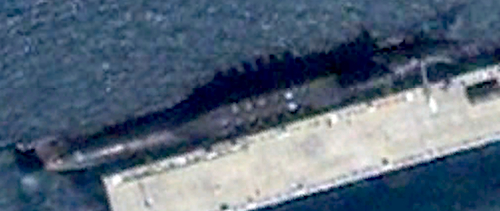
In this image from November 30, 2013, a Jin-class SSBN can be seen flashing its 12 missile tubes while docked at Longpo naval base on Hainan Island.
Longpo submarine base includes four piers for submarines, an underground submarine facility with tunnel access from the harbor and land-tunnels from the other side of the mountain, as well as a demagnetization facility. Longpo was the first base to get a demagnetization facility, which has since also been added to the East Sea Fleet near Ningbo.
The Hainan naval complex also includes the conventional submarine base at Julin, which also appears to be under expansion with new piers and a sea break wall under construction.
Approximately 12 kilometers (7 miles) northeast of Longpo is a military facility that appears to include four tunnels connecting to one or several underground facilities inside the mountain. Tugged away at the end of a lake inside a valley, the facility has a significant infrastructure with administrative and technical buildings as well as several camouflaged high-bay buildings surrounded by berms for blast protection during explosives handling.
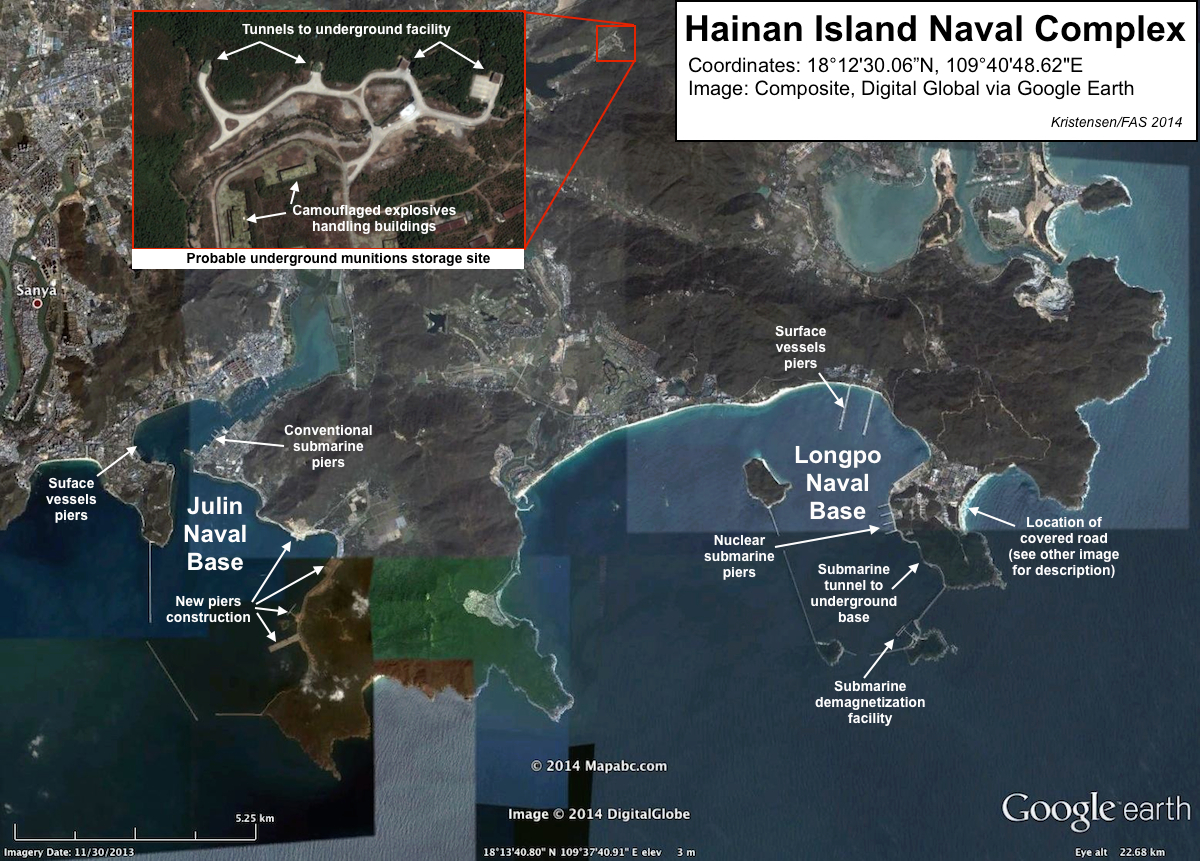
The naval complex on Hainan Island is spread across several locations with nuclear submarines based at Longpo, conventional submarines based at Julin, and a possible underground weapon storage facility north of the bases. Click for large version.
The Longpo base does not have a dry dock so nuclear submarines would have to sail to another base for maintenance or repair. The conventional submarine base at Julin has a 165-meter (550-feet) dry dock that could potentially accommodate a Jin-class SSBN, but it would be a tight fit. More likely are the 215-meter (706-feet) dry docks at the Zhanjiang Naval Base on the mainland north of Hainan Island, or the East Sea Fleet submarine base near Ningbo. Yet so far available commercial satellite images have not shown a nuclear submarine at either Julin, Zhanjiang (South Sea Fleet headquarters), nor Ningbo (East Sea Fleet headquarters), and it is unclear if the bases are certified for nuclear-propelled submarines. If not, then nuclear submarines based on Hainan Island would have to use a dry dock as far north as Jianggezhuang or Bohai for maintenance and repairs. That seem strange so I’m sure I’ve missed a naval dry dock somewhere closer to Hainan.
A unique new feature at Longpo is a 1.3-kilometer (0.8-mile) long covered railway completed in May or June 2010 (see below). The railway connects a high-bay building with possible access into the mountain at the eastern part of the base with one of the land-based tunnels to the underground submarine cave on the Longpo peninsula. The covered railway clearly seems intended to keep movement of something between the two mountains out of sight from spying satellites. Two turnoffs from the railway lead to a large building under construction with rail tracks inside. The purpose of the new facilities and rail is unknown but might potentially be intended for movement of SLBMs or other weapons between storage inside the mountain to the submarine cave for arming of SSBNs or SSNs.

A new covered railway constructed in 2010 might connect a missile handling building with the submarine cave on the other side of the mountain. Click for large version.
Before a roof was constructed to conceal the land-tunnel into the submarine cave, the rail tracks into the tunnel were visible on satellite images. Other features at this portion of the base include five ventilation stacks, the roof between the covered railway and tunnel entrance, and a coverage being constructed over a second tunnel road entrance (see above). These features are also visible on a tourist photo posted on Google Panoramio (see below).
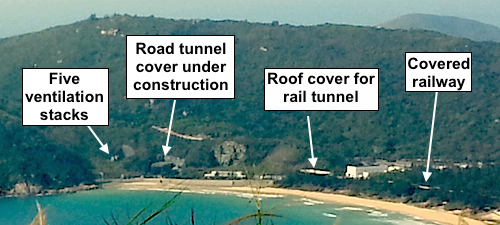
The east side of the underground submarine cave at the Longpo naval base on Hainan Island includes rail- and road-tunnels, ventilation stacks, and a covered railway.
Implications
With the emerging Jin-class SSBN fleet, China appears ready to add an important component to its nuclear deterrent. Although the focus of China’s nuclear posture is the land-based missile force, the Chinese leadership appears to view a triad of nuclear forces as a symbol of great power status. Commercial satellite images clearly show that the Chinese leadership has been spending considerable resources over the past decade building the infrastructure needed to support the SSBN fleet. The development is watched closely in India, Japan, and the United States as an example of China’s (modestly) growing and more sophisticated nuclear arsenal.
In building the Jin-class SSBN fleet, however, China appears more to mirror the nuclear postures of the United States, Russia, Britain and France rather than demonstrating a clear purpose and contribution of the SSBN force to China’s own security and crisis stability in general.
As a new second-strike capability added to the Chinese nuclear arsenal, the Jin SSBN fleet only makes strategic sense if it is more secure than the Second Artillery’s land-based ICBM force. Its justification must be based on a conclusion that the ICBMs are too vulnerable to a first strike and that a more secure sea-based second-strike force therefore is needed.
The ultimate test of the Jin SSBNs will be whether they can survive long enough at sea in a hypothetical war situation to provide a back-up deterrent at all. If they are too noisy, the Jins could be vulnerable to early detection and attrition, especially if they had to deploy to distant patrols areas in order for the missiles to be able to reach important targets. With a range of 7,200 to 7,400 kilometers (4,470 to 4,600 miles) – the range estimate given by the U.S. intelligence community for the JL-2 SLBM carried on Jin-class SSBNs, a submarine would need to sail deep into the Pacific Ocean to be able to target the U.S. west coast. To threaten Washington DC, a Jin SSBN would have to sail halfway across the Pacific (see map below). Not exactly safe travel for a submarine that is noisier than the ancient Russian Delta III SSBNs built in the 1970s.
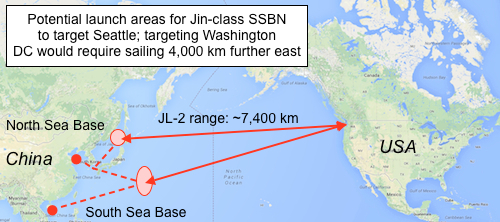
It is probably a fair assumption that U.S. attack submarines have already been trailing or monitoring the Jin SSBNs to record individual sound characteristics and observe operational patterns. Such information would be used to locate and, if necessary, sink the Chinese submarines in a hypothetical war.
The value of the Jin SSBNs is also dependent on their capability to communicate with the national command authority on land from submerged patrol areas. Secure and reliable communication is essential for the Chinese leaders to be able to exercise command and control of the nuclear missiles on the SSBNs. If communication is poor, the SSBNs could become irrelevant or, perhaps more importantly, downright dangerous to crisis stability if loss of contact caused Beijing to mistakenly conclude that one or more of the subs had been sunk by enemy action. That could, potentially, cause the Chinese leadership to conclude that the nuclear threshold had already been crossed and decide to activate its land-based nuclear forces in a way that would be seen by an adversary as preparation to launch.
Some of these issues may become clearer when China begins to operate the Jin submarines as a real SSBN force. Part of the public debate has been somewhat overblown with claims that Jin SSBNs will be able to target the continental United States from Chinese waters. They will not. And the DOD assessment that the Jins “will give the PLA Navy its first credible sea-based nuclear deterrent” is probably premature and certainly depends on what is meant by “credible.”
Whatever their ultimate capability may be, however, the Jin SSBNs and the infrastructure China is building are symbols of the extensive nuclear modernizations that are underway in all the nuclear-armed countries. The Chinese government says it “will never enter into a nuclear arms race with any other country,” but it is certainly in a technological race with the United States, Russia and India about developing improved and more capable nuclear weapons.
Additional resources: Previous articles about Chinese nuclear forces | Most recent (2013) Nuclear Notebook on Chinese nuclear forces.
This publication was made possible by a grant from the Ploughshares Fund. The statements made and views expressed are solely the responsibility of the author.


